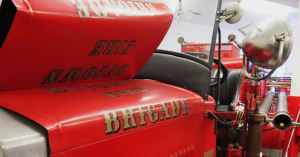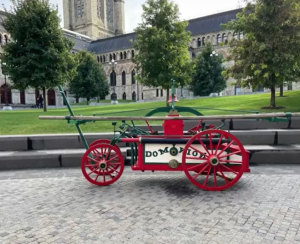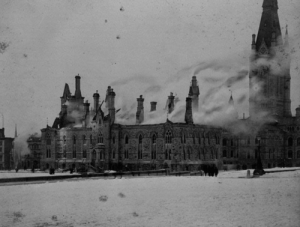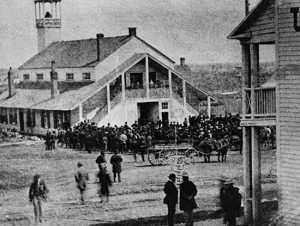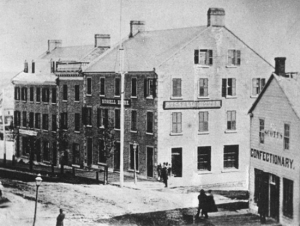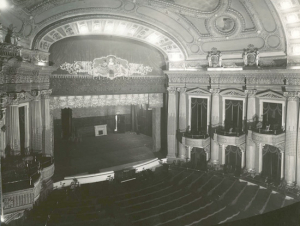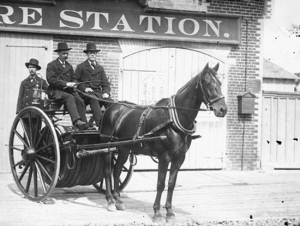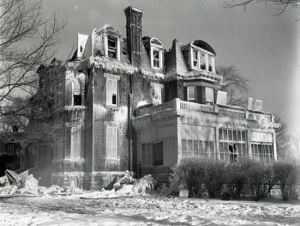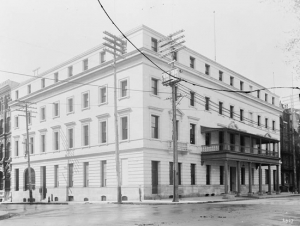Every City’s History is Written in its Ashes
The Historical Society of Ottawa’s Museum Club began its 2025 season on Friday May 2nd, 2025. On that afternoon, fifteen members and guests received a private guided tour of the Bytown Fire Brigade Historical Society facility at 2880 Sheffield Road, by their President, Peter McBride. Peter kept us all enthralled and entertained for 1 ¾ hours.
The Bytown Fire Brigade Historical Society was formed in the early 1980s, being incorporated as a non-profit in 1983. Its mission is to collect, preserve, conserve, restore, and display the artifacts and apparatus that tell the history of firefighting in Canada’s capital and the country as a whole. It opened its museum in the old fire station # 3 at Cumberland and Clarence in 1987. When the city sold that building, the museum moved to station # 6 at MacKay and Vaughn in 1988 before purchasing its current 2-storey home in 1990. The museum is open on Fridays between 09:00 and 13:00 but special arrangements can be made if you call or email.
The ground floor of their facility serves as a garage and maintenance area for the ten or so vehicles currently housed there. Many of these are over 100 years old and all have been restored to working condition. Included in these is “The Dominion”, Bytown’s first fire engine which was pulled through the streets by 16 firemen and then hand pumped, the 16 man team being replaced at regular intervals. It can still produce a stream of water 3 storeys high. Another piece on display is the 1886 Silsby horse-drawn steam pumper that was rushed out to the Village of Russell and saved the village from destruction. They also have four additional vehicles in storage at fire stations across the city. The Bytown Fire Brigage Historical Society is very active in the community and frequently brings out one of its vintage engines, as an attraction, in support of community events and projects.
The second floor, only accessible by stairs, has a mix of protective equipment from over the years, photos, badges, call boxes and many other artifacts that help to tell the 180 years of fire fighting in Bytown and Ottawa. On prominent display is a digitally restored replica of an 1840s banner from the Chaudière fire company, one of Bytown's earliest private firefighting companies. Peter showed us a fire mark, a plaque, which would be attached to the exterior of a building to indicate that it was covered by insurance, and so, if on fire, the fire should be fought or actions taken to salvage as much of its contents as possible.
The Bytown Fire Brigade has many more artifacts than it can display in its current location, but is always on the hunt for more and the stories behind them. They are also looking for more volunteers to help with their collection. You don’t need to be a firefighter or a former firefighter, you just need to want to help tell this long and fascinating story.
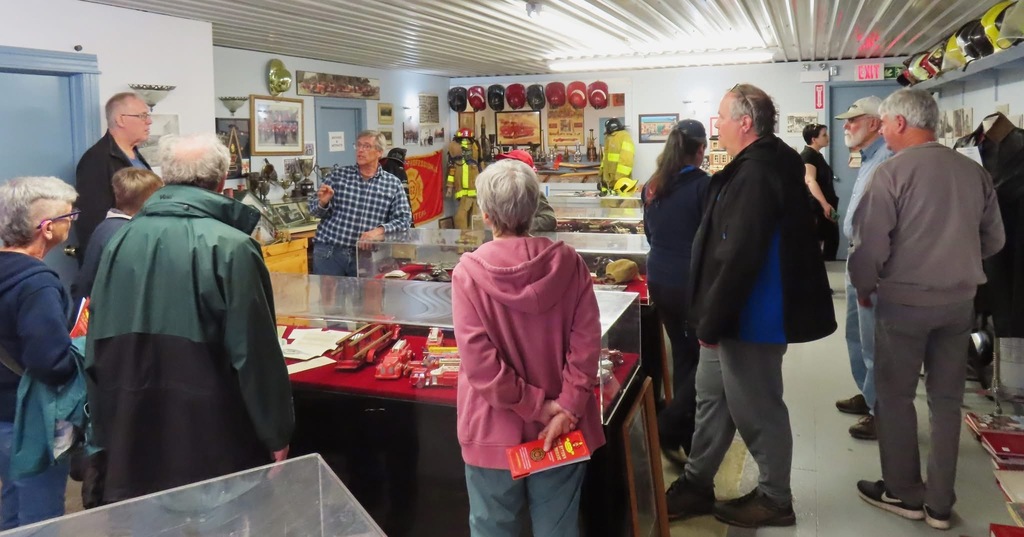 Museum Club visit to the Bytown Fire Brigade Historical Society photo by Ben Weiss
Museum Club visit to the Bytown Fire Brigade Historical Society photo by Ben Weiss
Fire Fighting from Early Bytown to Modern Ottawa
Given that our 1st English language presentation of our 2024 / 2025 series fell on September 11, it was most appropriate that our guest that night, Peter McBride, spoke about the contrast between fire fighting in Bytown and early Ottawa, as compared to fire fighting in Ottawa today. Peter is the President of the Bytown Fire Brigade, with whom we were proud to partner for this evening’s presentation. Chief McBride is a 32 year veteran of the Ottawa Fire Department, a registered safety professional, and a passionate advocate of Fire Literacy.
Peter started us at the very beginning of mechanized fire fighting in Bytown by showing us “The Dominion”, the first hand-pumper in Bytown. It was stationed on Barrack Hill with the Royal Engineers, but, pulled by soldiers, made frequent dashes into the town to help fight fires. Its hand-pump, which required a team of 16 men, could force a stream of water up to 3 storeys in height. Miraculously, it survived and is now in the collection of the Bytown Fire Brigade, who, after much restoration, bring it to special events and demonstrate its operation.
Peter explained that in these early days, “fire fighting”, was more a matter of attempting to save as much of the contents of the structures than the successful extinguishing of a fire. There was no water system, so no hydrants. The water was carried to the scene in water carts, or, if it was lucky enough to be beside a pond or river, water could be sucked into the hand-pumper. Most of the work was still done by bucket brigade.
Fire fighting at this time was not a service, it was a business. Peter told us that the money needed to purchase equipment was put up by local businesses or raised from subscriptions. There were no dedicated buildings for the storage of the equipment. He showed us a plaque, or fire mark, that would be displayed on a building to indicate that it had paid for some degree of protection or assistance. Towns were unplanned, thus there were no regulations on the types of buildings or activities that could be located together or regulations regarding the distances between buildings. In a town built primarily of wood, fires spread quickly.
In 1838, Uppertown, the most prosperous area, bought its own hand-pumper, “The Mutual”, likely with financial support from the insurance company. Later it and the fire brigade that used it were renamed as “The Chaudière”. They were a very proficient brigade and won many firefighting championships. Their banner survived, but in a highly deteriorated condition. The Bytown Fire Brigade has recently digitally remastered the banner. The story of this can be read here: Bytown Fire Brigade celebrates a banner year
In 1847, the first Hook and Ladder Company, another hand-pulled apparatus, was paired with “The Alliance”, the hand-pumper in Lowertown. Peter explained that the rivalry and distrust that existed between Uppertown and Lowertown in all things also infected the fire brigades, causing Council, in 1851 to establish a Fire Committee and in 1853 to authorize the building of dedicated engine houses and the purchase of additional engines. In 1867, John Langford was made Ottawa’s first Fire Chief, though firefighting was still performed by the privately run brigades. He was well respected, having come through the Chaudière, as was his Deputy from Lowertown.
In 1870, J. R. Booth purchased the first steam-powered pumper in the city, but this was far from the biggest fire related story of that year. Peter told us of the Great Fire of the Ottawa Valley, started by some railway workers clearing brush between Almonte and Pakenham. Driven by gale-force winds it reached Ottawa two days later. The Council called on all its citizens to fight the blaze and it was only by blowing up of the dam near Dows Lake, that flooded the Preston Street area, and a drop in the winds, that saved the rest of the city. In 1873 another fire on Daly Street destroyed an entire block. Change was needed.
Peter described the changes in fire protection that took place in 1874. The most important of these was the formation of the Ottawa Fire Department, now celebrating its 150th anniversary. This meant paid fire fighters and the phasing out of the volunteer brigades, which disappeared by 1887. The first hose companies were also formed in Ottawa at this time. Along with this, there was the introduction of a water works system and hydrants, though these were temperamental and unreliable. Fire call boxes were also installed to provide a rapid reporting of fires.
Peter explained that, as a lumber town, Ottawa faced extraordinary risks. These erupted in 1900 with the Great Fire that started in Hull and spread to Ottawa fueled by the tremendous piles of stacked lumber. The Historical Society has a pamphlet that provides more information on this fire 009. The Great Fire of Ottawa. By 1903, much of Ottawa had been rebuilt, as had the lumber piles of J.R. Booth. Fire broke out again, consuming much of the same area of Ottawa as it had just three years earlier. More on this now almost forgotten fire can be read in this fine article When the Great fire of 1903 ravaged through Preston. Despite two devastating fires, the lumber barons continued to stack timber within the city, seeming to have an unusual amount of influence over the decisions makers at Council.
Peter recounted a story that demonstrated the cooperative nature of fire fighters in different communities. In 1915 there was a fire in the Village of Russell and a call went out for help. Ottawa’s Silsby steamer was loaded onto a train and taken to save the village. The story has since been retold in a children’s book Silsby Saves the Day.
Peter concluded his look into the past with a reference to the 1916 fire that claimed the Centre Block of the parliament Buildings, and switched his attention to a brief review of the Ottawa Fire Service as it exists today.
The Historical Society of Ottawa has a pamphlet available online that also tells part of this story. 038. The Early Days of Fire Fighting in Ottawa
Peter described the challenges faced at amalgamation in 2001, when multiple fire departments, each with different staffing, training, equipment and expertise had to be merged into a single force. Managing this process was extremely complex and took some time. The Ottawa of today is a very complex city with multiple levels of governments, foreign embassies, heritage buildings and about 1.25 million inhabitants. It is also geographically one of the largest cities in Canada featuring everything from high-rise apartment towers to barns and silos. Naturally then the fire service of today is also large and highly complex.
Peter explained that although the public still think of fire fighters as the people who actually put out the fires, from the 45 current stations, there is now a lot more involved. The department now has divisions dedicated to the training of the crews in the newest techniques and on the newest equipment; to educate and inform the public in our multi-media world as to fire hazards; to enhance the safety of the fire fighters; a sophisticated communications structure to direct resources to and within emergencies; and to perform evidence-based research into the effects of new materials on the risk and spread of fires and how best to deal with these in the different built environments in which the fire service must operate both today and in the future. Apart from this, the fire fighters now respond to all kinds of emergencies, as diverse as medical responses to tornadoes and other climate-driven emergencies.
Peter concluded his presentation with an invitation to anyone who has stories, photos, or memorabilia related to fire fighting in Canada, and especially in our area to please get in touch with the Bytown Fire Brigade. They would love to talk with you.
Peter’s full presentation can be viewed at: The History of FireFighting, Early Bytown to modern Ottawa
The West Block Fire
11 February 1897
When people think of a fire on Parliament Hill, their thoughts likely go to the huge conflagration that destroyed the Centre Block in February 1916. To this day, the cause of that blaze remains unknown; a Royal Commission that investigated it did not come to a conclusion. Some people were convinced, and many still are, that it was an act of war-time German sabotage. Others believed that it was caused by careless smoking in the reading room.
Incredibly, however, the Centre Block fire wasn’t the first major blaze on Parliament Hill. Nineteen years earlier, the West Block, then being used as offices for the federal civil service, was almost consumed by fire.
At approximately 4:15 pm on Thursday, 11 February 1897, when most civil servants had already left for the day, a fire was detected in a small tower room used for storage close to an elevator in the attic storey. An elevator operator tried to extinguish it using a hand-held Babcock fire extinguisher. At the same time, three other men pulled out a fire hose that was installed in the corridor, but when they turned it on the stream of water barely extended three feet owing to low water pressure. Another Babcock extinguisher was brought into play, again without much impact. By this time, the fire was well established in the floor and wall.
At 4:35pm, an alarm was sent in the Central Station of the Ottawa Fire Department located off of Elgin Street. Within minutes, the horse-drawn hose reels arrived and were hooked up to hydrants. Meanwhile, the fire burst through the West Block’s wooden roof about 40 feet south of the Mackenzie Tower. An extension ladder was run up against the western wall of the building where a fireman tried to send a stream of water through an attic window. Unfortunately, only a meager stream came out of the big hose. The city’s low water pressure, made worse by several hoses running from the same Wellington Street water main, was responsible. Flames began to shoot out of a skylight located above the elevator shaft as the fire worked its way southward down the corridor.
In desperation, Fire Chief Young called out the steam-driven fire engines which used coal to heat a boiler to provide water pressure. The Union was stationed at the corner of O’Connor and Wellington Streets, while the Conqueror hooked up to the hydrant located on Parliament Hill at the nearest corner of the West Block. Both engines experienced what a journalist called “exasperating delays” to get water onto the fire. It took the Union almost thirty minutes to get its hose, which extended through the main entrance and up the stairs to the attic, into action owing to valve problems and other malfunctions. Meanwhile, the Conqueror, after failing to get sufficient water from hydrants on the Hill, possibly due to ice, had to be moved to a hydrant at the corner of Sparks and O’Connor Streets. A third fire engine from the E.B. Eddy Company was also brought in to help but to no effect as firemen discovered that its hoses were of a different calibre from that used by the city and couldn’t be coupled to city mains.
Through the evening, fire roared through the upper attic story of the building, fuelled by tinder-dry timbers, a warren of wooden panelled offices and piles of paper—government documents, briefing notes, and memoranda. Flames tore through the roof to the south-west of the Mackenzie Tower and then moved eastward reaching the middle of the Wellington Street side of the building, feeding on flammable materials found in a photographic studio and later in the draughting room of the Marine and Fisheries Department.
By 9:00pm, the whole top storey of the western wing of the building was gone. Shortly afterwards, the top storey of the eastern wing was ablaze. Two hours later, the northern and eastern wings were roofless.
Thousands of spectators, including the Governor General, Lord Aberdeen, and his wife, the Countess of Aberdeen, watched in horror despite the bitter cold; the temperature that evening had dropped to -18 degrees Celsius. It was quite a spectacle. The West Block’s turrets and chimneys were highlighted by the flames with the Mackenzie Tower rearing above the chaos.
While firemen battled the blaze, an army of civil servants and Dominion police worked frantically to empty offices of their documents and other valuables. Even if not immediately threatened with fire, offices on the lower floors were inundated by the water being hosed onto the attic level above. Sleighs of all sorts were pressed into service to evacuate things to the safety of the Langevin Block on the other side of Wellington Street. In the Department of Public Works alone, the Minister and his officials managed to save several tons of books and papers. In the Customs Department, rubber sheets requisitioned from Militia stores were used to protect precious books and papers from water damage.
At 11:00pm, at the height of the fire, Ottawa’s mayor called Montreal for emergency back-up. A detachment of fifteen men from the Montreal Fire Department, equipped with a fire engine and two hose reels answered the call. They immediately set off for Ottawa by train, arriving at 3:00am the next morning. But by this time, the worst was over. The fire had been largely subdued, leaving only glowing embers and smoke.
The next day, Ottawa residents could see for themselves the extent of the damage. Virtually the entire building had lost its top attic floor. The only part of the West Block that was spared was the new wing north of the Mackenzie Tower. This wing, being of more modern construction than the rest of the building, had a metal roof.
The fire continued to smolder despite the deluge of water that had been sprayed onto the building. One fire engine, the Conqueror, was kept pumping water onto the West Block through Friday. However, by 3:00pm, it had to cease operations, having exhausted its stock of hard Welsh coal used to fire its boiler. A switch to ordinary bituminous coal proved unsuccessful in maintaining sufficient pressure to drive the water the long distance from the hydrant at Sparks and O’Connor Streets to the top of the West Block on Wellington Street. The fire revived. An alarm was sounded bringing Chief Young, who had just returned to the station for supper, back on the scene along with another hose reel and two ladder trucks. It wasn’t until 8:00pm that the West Block fire was finally subdued by Ottawa firemen after almost 30 hours of continuous gruelling work in sub-zero temperatures.
The clean-up afterwards was also demanding. Owing to the cold temperatures, hoses were buried under as much as a foot of ice. Even if uncovered, the hoses were frozen stiff, requiring them to be thawed out before being moved. The concrete floor immediately under the attic level was also buried deep in debris.
Even before the fire was out, Cabinet met to discuss rebuilding and to find temporary quarters for affected departments. Only the offices of two departments, Inland Revenue and Railways and Canals remained usable. Space was found in the Nagle building opposite the main entrance to Parliament on Wellington Street for Public Works, Trade and Commerce, Customs and the Public Works departments. The Marine and Fisheries Department moved to offices in the Slater Building on Sparks Street. With more than a foot of water sloshing about in the basement of the West Block where the Dominion Archives were kept, it was imperative to move irreplaceable documents to safety in the Langevin Block. A unit of the Governor General’s Foot Guards stood guard while the papers were transferred.
Amazingly, there were few injuries in the disaster. A fireman suffered a seriously cut finger when a glass skylight fell on him. Another man was hit on the head by a piece of slate thrown from the top of the building during the clean-up; his injury, while painful, was not serious. There were some close calls, however. Four firemen who were fighting the fire in the attic felt the wooden floor beneath them begin to give way. They rushed to a ladder at the window. The first three men made it to safety but the fourth, Harry Walters from the Central Fire Station, had just reached the window when the floor disappeared from under him. He was saved from by William Thompson who managed to grab him.
The official report of the disaster didn’t reach a conclusion about the cause of the fire, though newspaper reports speculated on the possibility of a carelessly discarded cigar or cigarette. Later, a consensus opinion blamed the fire on a “heating apparatus.”
The report did conclude that a doorway cut into a fire wall to permit movement from one office to another helped to spread the blaze. As well, valuable time in fighting the fire was lost owing to firemen being unfamiliar with the layout of office rooms and being unwilling to accept direction from departmental officials. Overall, the report found that officials and workmen had exerted themselves “to the utmost” to prevent the fire from spreading and to save valuable papers and documents. “Nothing which could be done was left undone.”
The cost of the blaze was approximately $200,000. This amount did not, however, include the loss of valuable papers and documents. As the West Block was not insured, the government had to bear the entire cost of reconstruction. The Premier, Wilfrid Laurier, immediately requested a “Governor General’s warrant” to raise $25,000 to cover the initial costs associated with the fire, including the rental of new office accommodations for displaced government offices. The warrant was approved General Alexander Montgomery Moore, Commander of Canada’s Militia, who was acting as the Administrator of Canada on behalf of Lord Aberdeen.
Work on re-building commenced quickly. As a stop gap, a temporary roof, 29,000 square feet in size, was erected at a cost of $4,500. This was later replaced by a fire-proof roof covered with copper. Work also began on the clean-up, the re-building of new offices and the re-furbishing of those offices that managed to survive the blaze but were water damaged. Labourers were paid $1.00 to $1.25 per day. Carpenters and painters received $2.00 per day.
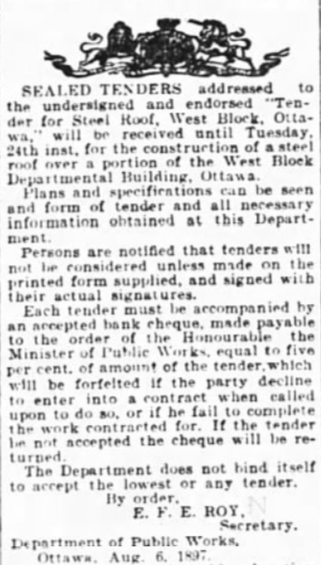 Call for tenders for repairs to West Block, Ottawa Journal, 9 August, 1897.Rebuilding became highly political. The Conservative opposition accused the government of featherbedding and hiring only Hull workers in order to curry favour with Hull voters ahead a forthcoming federal by-election in Wright Country which encompassed Hull. The Liberal candidate, Mr. Louis Napoléon Champagne, was unapologetic saying Hull wasn’t the only city that had obtained patronage as other places got their share of federal business. He added that the Liberals were prepared to do it again “to those who are really friends of Mr. Laurier.” Champagne won the contest. The day after the by-election, 50 of the 313 workers on the West Block were dismissed, with further dismissals expected in order to reduce the size of the work force to what was appropriate.
Call for tenders for repairs to West Block, Ottawa Journal, 9 August, 1897.Rebuilding became highly political. The Conservative opposition accused the government of featherbedding and hiring only Hull workers in order to curry favour with Hull voters ahead a forthcoming federal by-election in Wright Country which encompassed Hull. The Liberal candidate, Mr. Louis Napoléon Champagne, was unapologetic saying Hull wasn’t the only city that had obtained patronage as other places got their share of federal business. He added that the Liberals were prepared to do it again “to those who are really friends of Mr. Laurier.” Champagne won the contest. The day after the by-election, 50 of the 313 workers on the West Block were dismissed, with further dismissals expected in order to reduce the size of the work force to what was appropriate.
Repairs were sufficiently advanced within a year to permit public servants to re-occupy their offices. But work on the West Block was not completed until 1899, more than two years after the fire.
The West Block fire led to considerable reflection on the size of the Ottawa Fire Department and its equipment, and the extent of the fire hazard posed by public buildings, particularly those on Parliament Hill. The Citizen opined that Ottawa was “comparatively helpless in the presence of a major conflagration.” The “noble government structures,” which cost $5-6 million to build, were the “crowing beauty of the Capital of the Dominion.” Yet, the buildings, constructed using wooden beams and partitions and filled with irreplaceable records, papers and documents, were fire traps. The newspaper contended that should fire break out in either the Central Block or the East Block, “the result would be equally bad” as what had just occurred.
It added that the House of Commons was particularly at risk since the Centre Block was built on a higher elevation that the West or East Blocks which meant that water pressure would be even more of a problem. The Library of Parliament was “the most serious case of anxiety,” as it held more than $1 million in books, and contained no dividing walls. Given these risks, the newspaper was appalled that smoking was permitted and argued that smoking should be banned in all public buildings.
These were prophetic words. Virtually nineteen years to the day later, on 3 February 1916, the Centre Block was destroyed by fire. The precious Library of Parliament was the only part of the building saved, owing to the quick thinking of a librarian who had the presence of mind to close an iron fire door that separated the structure from the main part of the building.
Over the decades that followed, the West Block was much altered. In 1911, a new wing was built linking the east and west wings to form an enclosed quadrangle. During the mid-1950s, the West Block suffered from extensive renovations which were unsympathetic to the original design. However, this was better than the alternative. In 1956, the St. Laurent government almost manage to achieve which the 1897 fire had failed to do—the complete destruction of the beautiful and historic Gothic-revival building. The Federal District Commission, the fore-runner of the National Capital Commission, wanted to replace it with a modern office tower. But after a nation-wide protest, wiser heads prevailed and the building was saved. However, the neighbouring Supreme Court building was not so lucky. It was destroyed to make way for a parking lot.
Today, the enclosed quadrangle in the middle of the West Block, now covered by a glass ceiling, is the temporary home of the House of Commons while the Centre Block undergoes much needed restoration and renovation.
Sources:
Ottawa Daily Citizen, 1897. “The Western Block in a Blaze,” 12 February.
————————-, 1897. “The Second Alarm,” 13 February.
————————-, 1897. “A Present Danger,” 13 February.
————————-, 1897. “After The Fire,” 15 February.
————————-, 1897. “Their Usefulness Done,” 25 March.
————————-, 1897. “West Block Blaze,” 24 June.
————————-, 1898. “West Block Fire,” 24 March.
Ottawa Evening Journal, 1897. “The Talk of Today,” 13 February.
——————————, 1897. “The Official Report,” 17 February.
—————————–, 1897. “The Wright Campaign,” 17 March.
—————————–, 1897. “An Insult To Hull,” 18 March.
—————————–, 1897. “One Million Dollars,” 27 March.
—————————–, 1899. “West Block Repairs,” 9 August.
Privy Council Office, 1897, “Special Warrant $56,000 [sic] [$25,000], Fire, Western Departmental Buildings – Minister of Public Works,” 17 February, Library and Archives Canada.
Story written by James Powell, the author of the blog Today in Ottawa's History.
Retired from the Bank of Canada, James is the author or co-author of three books dealing with some aspect of Canadian history. These comprise: A History of the Canadian Dollar, 2005, Bank of Canada, The Bank of Canada of James Elliott Coyne: Challenges, Confrontation and Change,” 2009, Queen’s University Press, and with Jill Moxley, Faking It! A History of Counterfeiting in Canada, 2013, General Store Publishing House, Renfrew, Ontario. James is a Director of The Historical Society of Ottawa.
The Ottawa City Hall Fire
31 March 1931
Ottawa’s first city hall was a wooden structure built close to Elgin Street in 1848 by Nicholas Sparks. It had originally been a market. But when the market failed the following year, eclipsed by the more popular Byward Market in Lower Town, Sparks donated the building to Bytown (later known as Ottawa) as the town’s city hall. For close to thirty years it served in this capacity, for a time also doubling as the community’s fire hall. Pressed for space, the city’s municipal offices moved into a bespoke building constructed in 1876 on an adjacent lot located on Elgin Street between Queen and Albert Streets—roughly where the National Arts Centre is today. The four-storey, stone building was designed by the architects Henry H. Horsey of Ottawa and Matthew Sheard of Toronto in the French Empire style, a mode of architecture which was much admired during the late nineteenth century. The City Hall, built for $85,000, was apparently considered by many at the time as “the finest example of municipal architecture.”
But by the 1920s, the City had once again outgrown its now aging city hall. In 1927, the Liberal government of Mackenzie King came to an agreement with the City over the eventual expropriation of the building, along with the Police and Central (No. 8) Fire Station buildings located behind it, the Russell Hotel, the Russell Theatre, and the Post Office, in a grand plan to beautify Ottawa through the creation of Confederation Park, the construction of a War Memorial to honour Canadian service personnel who died during the Great War, and the widening of Elgin Street. Although the Russell Block was expropriated in 1927 by the federal government, and the City itself took over several buildings including Knox Presbyterian Church for the widening of Elgin Street, plans for the park stalled with the coming of the Great Depression in 1929 and the election of a parsimonious Conservative government under R. B. Bennett in 1930.
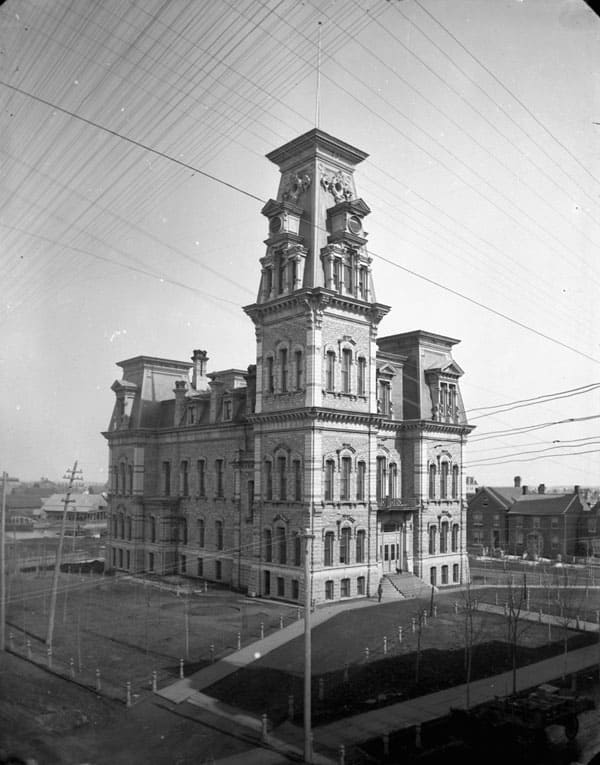 Ottawa City Hall, 1877-1931, Elgin Street
Ottawa City Hall, 1877-1931, Elgin Street
Library and Archives Canada, Mikkan 3325359.The municipal offices were still located in their Elgin Street premises when a fire gutted the building. During the evening of 31 March 1931, two men passing by the nearby Post Office spotted smoke and flames coming from the top corner of the north-east side of the City Hall. The passers-by rushed to the No. 8 Fire Station. The fireman on duty initially thought the men were pulling an April Fool’s prank on him. But after stepping outside, he quickly call out the fire fighters. The first alarm sounded at 9.25 pm with a second alarm sounding a few minutes later, calling in fire fighters from across the city.
Firemen initially entered the east tower of the Hall that led to the office of Vincent Courtemanche, the City’s paymaster. Courtemanche was working late that night preparing workers’ pay sheets. Hearing the hubbub outside his office, he initially thought a prisoner had escaped from the police lock-up. On finding that the City Hall was ablaze, he rushed upstairs to warn Finance Commissioner Gordon who was also working late. The two men fled the building after retrieving $8,000 in cash and $20,000 in cheques. Gordon also managed to save a cheque-writing machine newly purchased for $1,000. Reportedly, a one-ton safe was dragged be two policemen and two volunteers from the Treasury Department to the offices of Hugh Carson Ltd, the maker of leather goods at 72 Albert Street, for safe-keeping.
The fire started in the office of T. B. Rankin, the accountant of the City’s engineering department located on the northeastern corner of the top floor. Firemen were able to bring two hoses to Rankin’s office, but the blaze had already spread through the false ceiling and could not be contained. It quickly swept through the neighbouring offices of the Waterworks department and the draughting room of the Works department. The office of the building inspector was also consumed by the flames.
Downstairs, a meeting of the Central Council of Social Agencies was underway in the Board of Control boardroom. Controller J.W. York, who was attending the meeting, immediately called Mayor Allen and other councilmen. After saving the records of the Board of Control, Controllers Gelbert and York, along with a Journal newsman, went upstairs to salvage records from the Waterworks and Works departments. The three men had a narrow escape when a wall collapsed under the pressure of the water from the firemen’s hoses on the other side of the wall of the room they were in. They were forced to drop everything and flee to safety. Following his arrival on scene, Mayor Allen took charge of saving documents. Men frantically slid steel filing cabinets filled with important municipal records down the building’s marble staircase to get them outdoors.
The fire was intense. Seven firemen were injured when the top floor on which they were working collapsed without warning, dropping them more than fifty feet into the basement. Some were pinned for more than an hour under smoldering debris while their colleagues desperately dug to free them. Rev. Father J. L. Bergeron of Ottawa University smashed the glass of a basement window and crawled in to administer last rites to the pinned men. Fortunately, the sacrament was not needed. All the trapped firemen were rescued by their colleagues who “worked like Trojans” to get them out. None of their injuries proved to be life-threatening. But it was a narrow escape. Later in the Water Street hospital, one of the injured admitted that they had received “a real break,” though he phlegmatically added that it was “all part of the game.” Ironically, just two weeks before the fire, the City’s Board of Control had received a report indicating that the Works department vault was supported by only one girder that placed it at risk in the event of a fire. The Board of Control had discussed the building of a more secure vault at the rear of the City Hall at a cost of $70,000 dollars but no decision had been taken.
One hundred and twenty-five firemen from across the city were called out to fight the blaze. To help increase the water pressure, an old steam engine from No. 7 Fire Station was brought into action. A detachment of the RCMP was also called in to help Ottawa police keep more than 20,000 on-lookers from hindering the work of the fire brigade, and to keep them a safe distance from falling debris and flying embers. Just after midnight, tons of masonry from the stone tower at the south-west corner collapsed sending the vault in the Assessment department through the floor through the Health department, the Board of Control room, and the Central Canada Exhibition offices.
Fortunately, the fire didn’t reach the ground floor office of N. H. Lett, the City Clerk. His precious records of elections, plebiscites, and vital statistics survived the fire. Paintings and other valuables were also rescued, including portraits of former mayors and pictures of the King and Queen. Small busts of Sir John A. Macdonald and Sir Wilfrid Laurier were later found in the Mayor’s Office intact albeit somewhat water damaged. The stock of a little cigar stall that stood at the front entrance was also saved. Estimated losses associated with the fire were placed at more than $200,000. Total insurance coverage amounted to only $91,200 for the building and $10,000 for contents. The cause of the blaze was never ascertained.
Even before the flames were extinguished, work began on finding temporary accommodations for civic workers. The City obtained permission from the federal Department of Public Works to use two floors of the Regal building on O’Connor Street that had just been vacated by the Department of Labour for the Confederation Building on Wellington Street. But efforts to move furniture into the building and set up a switch board were quickly halted when the owner of the building objected. As the City began seeking other alternatives, Mayor Allen and other City Controllers worked out of Controller York’s law office. Some city services set up temporary offices at the Coliseum on Bank Street, others on Bank Street and in LeBreton Flats. Three days after the fire, the City found satisfactory accommodations in the Transportation Building on Rideau Street. (The Transportation Building, built in 1916, stands at the corner of Rideau Street and Sussex Drive and is now incorporated into the Rideau Centre.) Previously the home of the Auditor General, the City rented the top three floors at a cost of $22,500 per year, equivalent to $1.50 per square foot. Most civic departments eventually moved here.
Despite the confusion in the days immediately following the fire, most municipal services were unaffected. City staff were paid on time that week by City Paymaster Courtemanche using temporary facilities at the Police Station. Only Ottawa’s sweethearts were disappointed. City Clerk Lett halted the issuance of marriage licences for twenty-four hours owing to his stock of blank certificates being waterlogged.
The Mayor and Council quickly initiated talks with the Bennett government over the future of the gutted City Hall building. The Mayor proposed that the federal government purchase the land for $2 million consistent with the 1927 plan to establish Confederation Park on the site. But Bennett’s government demurred. The price tag was simply too great. Discussions then focused on whether to restore the damaged building, rebuilt on the same site, or seek an alternate site for a new City Hall. The Ottawa Journal was of the view that restoring the damaged building was a waste of money. It opined that the fire had shown the “folly and danger” of its “ugly, wooden towers which architects of a generation or two ago seemingly insisted upon.” It added “The truth is that a lot of mid-Victorian architecture was as slovenly as the dress of a lot of mid-Victorian women – and about as useless.” What had been viewed as the epitome of fine municipal architecture fifty years earlier was now thoroughly out of fashion and a fire hazard to boot.
It took some months for Council to make its decision to demolish the gutted building, contracting with D. E. Mackenzie to pull it down for $1,800 in October 1931. The City retained ownership over the cornerstone, and all plaques and memorials. The decision to demolish the old building was not unanimous. Mayor Allen and Controller Gelbert favoured erecting a temporary roof and using the basement as the civic employment office. A number of potential locations were discussed for a new home for the City Hall, including sites on Wellington Street next to St. Andrew’s Church between Kent and Lyon Streets, the west side of Elgin Street between Queen and Albert Streets, as well as rebuilding on the existing site. But with a price tag of $600,000, and in light of the considerable expenditures the City had recently incurred on sewer upgrades following the sewer explosions earlier that year, and the cost of building a water purification system, city fathers believed it prudent to wait until better economic conditions prevailed before re-building. It wouldn’t be until the 1950s that Ottawa moved into new accommodations constructed on Green Island. The new City Hall building was officially opened by Princess Margaret in early August 1958. The structure, now known as the John G. Diefenbaker building, is currently occupied by Global Affairs Canada.
With the creation of a single-tier city structure, and the merger of surrounding communities into the City of Ottawa in 2001, city government moved to the offices of the defunct Regional Municipality of Ottawa-Carleton at the corner of Laurier Avenue and Elgin Street, facing Confederation Park. Interestingly, this is roughly the site proposed for Ottawa’s City Hall by the Ottawa Citizen newspaper in 1931.
Sources:
Citizen (The), 1931.”5 Firemen In Narrow Escape, Property Loss $15,000,” 1 April.
—————-, 1931. “Ask Government If It Wants City Hall Razed,” 1 April.
—————-, 1931. “City Hall Built in 1875-76, Renovated During 1910-11,” 1 April.
—————-, 1931. ‘For A New City Hall,” 2 April.
Ottawa Evening Journal (The), 1931. “Mayor and Board See Premier About City Hall,” 1 April.
————————————, 1931. “How Ottawa City Hall Looks Today After Night Blaze of Six Hours,” 1 April.
————————————, 1931. “Three firemen Say They Had A Lucky Break,” 1 April.
————————————, 1931. “Cause of Blaze – A Mystery To Chief Lemieux,” 1 April.
————————————, 1931. “Thrilling Scenes And Brave Rescues Mark City Hall Fire,” 1 April.
————————————, 1931. “Fourth Floor Collapses Trapping Seven Men Under Debris In Cellar,” 1 April.
———————————–, 1931. “Board in Special Meeting Decides on New Offices,” 1 April.
———————————-, 1931. “Ask Government $2,000,000 For City Hall Site,” 2 April.
———————————-, 1931. “City Business Carried on Despite Difficulties Faced Securing Temporary Offices,” 2 April.
———————————-, 1931. “Why Waste $150,000 On An Inadequate Building,” 2 April.
———————————-, 1931. “Wretched Wooden Towers,” 2 April.
———————————-, 1931. “Will Consider Construction New City Hall on Present or Some Other Location,” 3 April.
———————————-, 1931. “New Quarters For City Staff Are Arranged,” 4 April.
———————————-, 1931. “Will Demolish The Fire Ruins Of City Hall,” 12 August.”
———————————-, 1931. “Another Site For New City Hall Offered,” 18 September.
———————————-, 1931. “Decide To Tear Down City Hall Ruins At Once,” 3 October.
———————————-, 1931. “Still Unable Start Tearing Down Building,” 6 October.
Story written by James Powell, the author of the blog Today in Ottawa's History.
Retired from the Bank of Canada, James is the author or co-author of three books dealing with some aspect of Canadian history. These comprise: A History of the Canadian Dollar, 2005, Bank of Canada, The Bank of Canada of James Elliott Coyne: Challenges, Confrontation and Change,” 2009, Queen’s University Press, and with Jill Moxley, Faking It! A History of Counterfeiting in Canada, 2013, General Store Publishing House, Renfrew, Ontario. James is a Director of The Historical Society of Ottawa.
The Russell House Hotel
8 June 1863
During the late nineteenth and early twentieth century, the centre of Ottawa’s social life was the Russell House Hotel that stood on the southeast corner of Sparks and Elgin Streets. It was a grand and stately hostelry that dated back to about 1845. Originally, the hotel was a three-storey structure with an attic and tin roof known as Campbell’s House after its first owner. Located in Upper Town close to the Rideau Canal, it was the main stopping point for people vising Bytown, later known as Ottawa. Its food and other supplies came from Montreal by river in the summer and overland by sled in the winter.
When Queen Victoria selected Ottawa as the capital of the Province of Canada in 1857, the future of the small community was secured. Its population soared after the Parliamentary and Governmental buildings were completed in the early 1860s, and civil servants and Members of Parliament decamped from Quebec City to Ottawa. Thinking ahead to the business opportunities that this influx of people would bring, Mr James A. Gouin from Quebec City bought Campbell’s Hotel. He renamed it the Russell House after the Russell Hotel in Quebec City where he had worked.
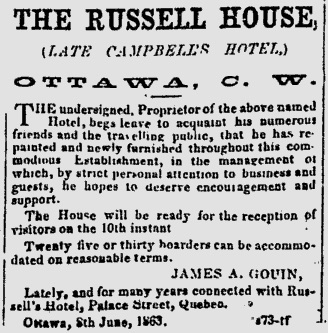 Advertisement, The Ottawa Citizen, 17 July 1863Advertisements dated 8 June 1863 appeared regularly in the Ottawa Citizen through the latter part of that year announcing that Gouin, the new proprietor of the Russell House, had completely repainted and refurnished “this commodious Establishment,” and that “on the 10th instant” would be ready to receive visitors. The hotel could accept twenty five to thirty boarders “at reasonable rates.” The advertisement added that Gouin had been “connected for many years with Russell’s Hotel, Palace Street [Côte du Palais], Quebec.” This hotel, located just a few blocks from the provincial parliament buildings (now the site of Parc Montmorency), had been owned by the Russell family, Americans who had apparently settled in Quebec when it had been the centre of the lumber industry. Gouin later built the Caledonia Springs Hotel, a famous spa in eastern Ontario, and was appointed Ottawa Postmaster by Sir John A. Macdonald.
Advertisement, The Ottawa Citizen, 17 July 1863Advertisements dated 8 June 1863 appeared regularly in the Ottawa Citizen through the latter part of that year announcing that Gouin, the new proprietor of the Russell House, had completely repainted and refurnished “this commodious Establishment,” and that “on the 10th instant” would be ready to receive visitors. The hotel could accept twenty five to thirty boarders “at reasonable rates.” The advertisement added that Gouin had been “connected for many years with Russell’s Hotel, Palace Street [Côte du Palais], Quebec.” This hotel, located just a few blocks from the provincial parliament buildings (now the site of Parc Montmorency), had been owned by the Russell family, Americans who had apparently settled in Quebec when it had been the centre of the lumber industry. Gouin later built the Caledonia Springs Hotel, a famous spa in eastern Ontario, and was appointed Ottawa Postmaster by Sir John A. Macdonald.
Like its namesake at Quebec, the new Russell House Hotel was conveniently located at short stroll from Parliament Hill. It immediately attracted the great and powerful, becoming the home for many Members of Parliament, including Sir John A. Macdonald, in need of a place to live while the House of Commons and Senate were in session. On Confederation Day, 1 July 1867, the Russell House was full, hosting prominent Canadians from across the country who had come to Ottawa to bear witness to that first Dominion Day, now known as Canada Day. Other prominent early guests included George Brown, the fiery Liberal MP. He was apparently staying at the Russell when he penned a complaint to Macdonald regarding the cost of building the Parliament buildings saying: Never mind expenses. Go ahead. Ruin the Country. Stop at nothing. Why not fountains and parks and gardens? It is also believed D’Arcy McGee, the Canadian nationalist and Father of Confederation who was assassinated in 1868 penned some of his poems at the Russell House Hotel.
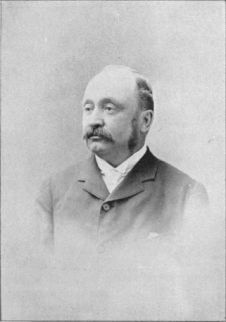 Mr James A. Gouin, First Proprietor and Manager of the Russell House Hotel
Mr James A. Gouin, First Proprietor and Manager of the Russell House Hotel
The Canadian Album, 1895.The hotel was enlarged during the 1870s, with the “New Wing” erected on the Elgin Street side across from the Central Chambers (which still stand today). The hotel’s dining room was located in this wing. In 1880, the original Campbell’s Hotel building was torn down and was replaced by a new, larger, five-storey building on Sparks Street, built in the French Second Empire style, with shops located at ground level. Shortly afterwards, a final extension was made on the east side of the building towards what was then known as Canal Street. (Canal Street disappeared with the building of Confederation Plaza and the extension of the Driveway in 1928.) In the end, the hotel boasted more than 250 rooms.
The hotel reached its peak of popularity during the 1880s and 1890s, and was famous across the country as the place to stay while visiting the nation’s capital. The hotel’s manager, François Xavier St Jacques, who succeeded Gouin, was a living legend. Known as “the Count,” St Jacques was a great eccentric who greeted guests wearing high heel shoes that gave him an odd gait. Visiting Victorian luminaries, such as Oscar Wilde, Lilly Langtry, Lillian Russell, and the boxer “Gentleman” Jim Corbett were Russell House guests. Sir Mackenzie Bowell lived there for seventeen years, including when he was prime minister from 1894 to 1896. Sir Wilfrid Laurier was another long-term tenant, staying at the Russell for ten years before moving to Laurier House in 1897. The hostelry with its long bar and leather chairs was also the site of many political intrigues and debates over the decades, second only to the Parliament buildings themselves.
The Russell House Hotel, synonymous with Ottawa and renowned across the country for elegance and fine dining, was eclipsed by the Château Laurier Hotel when that hotel opened for business a short distance away in 1912. By then, the grand old lady had become worn and shabby. In 1923, several thousand dollars was spent upgrading the main entrance and the rotunda, but it was too little too late. By that point, the hotel was rat and cockroach infested.
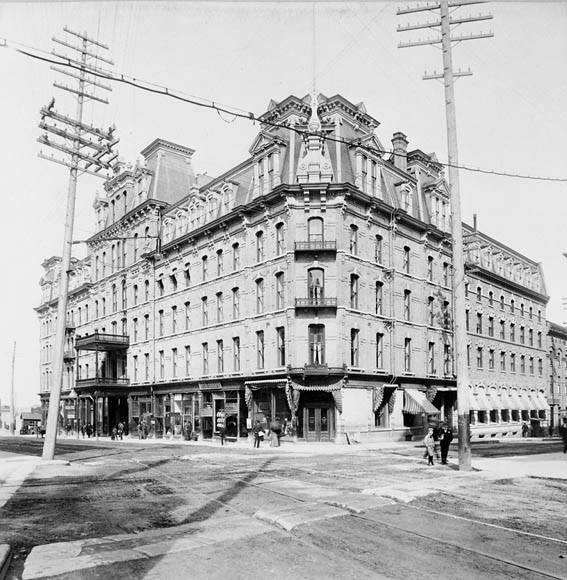 The Russell House Hotel, July 1893
The Russell House Hotel, July 1893
Topley Studio Fonds/Library and Archives Canada, PA-008436.At noon on 1 October 1925, the hotel closed for good, a victim of rising costs and declining occupancy rates. Paradoxically, bookings during the hotel’s last summer had been strong, with the hotel attracting both tourist and convention business; the Russell was the headquarters of the Dominion Trades & Labour Congress that year. But that was not enough to keep the venerable hotel from closing. On its last night, more than 150 guests were booked into the hotel. They had to take “pot luck” for supper in the cafeteria as food supplies were limited. In the rotunda, a number of old timers sat on battered chairs reminiscing about happier times. One hotel veteran was moved by the occasion to pen a poem entitled “Old Russell Farewell.” Its first verse went:
Adieu, adieu old rendezvous
With saddened hearts we’re leaving you;
‘Twas here friends were wont to meet;
Here argued we affairs of state,
How oft’ we talked long and late,
To make the other fellow know.
Ah! Life is but a passing show.
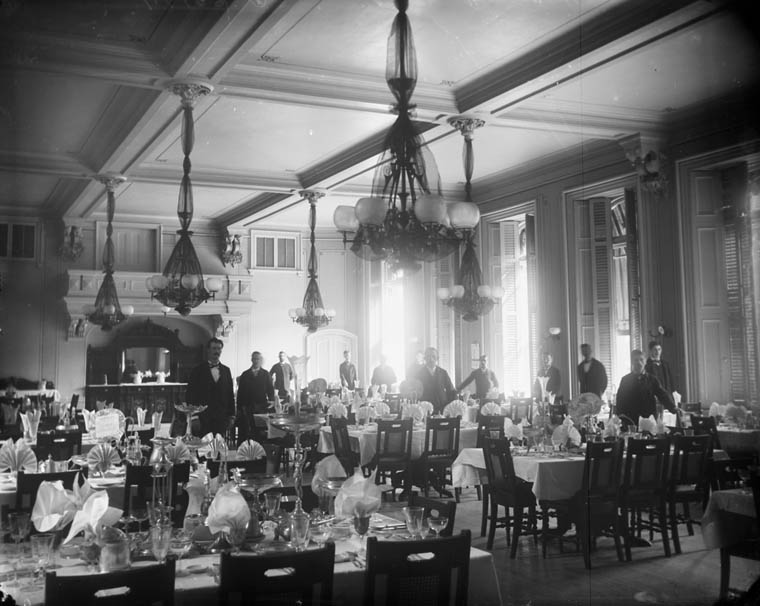 Russell House Hotel Dining Room, May 1884
Russell House Hotel Dining Room, May 1884
Topley Studio/Library and Archives Canada, PA-027059.The next morning, with guests forced to seek their breakfast outside of the hotel, the place was virtually deserted. By shortly after noon, the only employee left out of a staff of 150 was a desk clerk tallying up the last day’s receipts. Gone also were the hotel’s “permanent” residents who had called the hotel home. One had been living at the Russell for thirty-three years.
Initially, its then owner, Russell L. Blackburn, planned to tear down the old hotel and replace it with a modern $1 million hostelry. However, Ottawa City Council balked at his demand to fix his property tax at $7,400 for twenty years. The empty building went into limbo, though the many ground-floor stores continued to operate until the Federal Capital District (FDC), the forerunner of the National Capital Commission, expropriated the Russell block of buildings and torn them down as part of its efforts to beautify the capital. In its place, the FDC built Confederation Plaza in commemoration of the diamond anniversary of Confederation in 1927.
The FDC bought the hotel property and the adjacent Russell Theatre property for $1,270,379.15 (equivalent to roughly $17.7 million in today’s money). The deal was still incomplete when just before midnight on 14 April 1928, the hotel went up in flames in a massive fire. Virtually all of Ottawa’s available fire equipment, which at the time was still being pulled by horses, were called in to tackle the blaze. Five firemen were injured by falling debris and flying glass. The cause of the fire was never ascertained. There was a suspicion of arson as first responders found fires in various places on different floors. However, the fire marshal speculated that had the fire been due to an electrical fault, the fire could have easily spread through the walls and floors before the alarm was called in. Alternatively, the evening’s high winds could have carried embers from floor to floor through the hotel’s many broken and open windows.
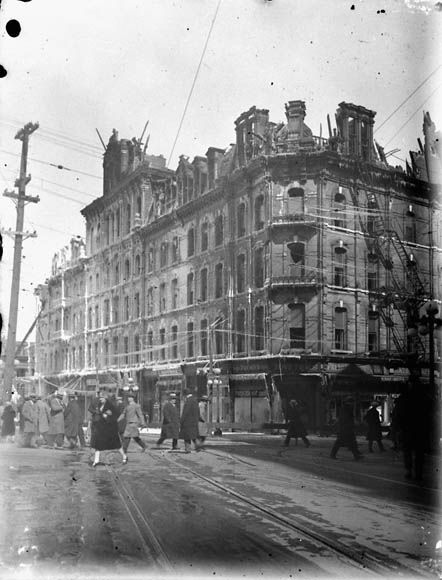 Russell House Hotel after the fire, 1928,
Russell House Hotel after the fire, 1928,
Samuel J. Jarvis/Library and Archives Canada, PA-025085.Thousands of Ottawa citizens watched the firemen fight the blaze. Many were in evening clothes having just left parties and dances. Guests at the Château Laurier Hotel located across Connaught Plaza from the Russell watched the fire from the windows of their rooms. Other spectators arrived by car, with the best parking spots on Parliament Hill near the East Block. There, people watched in the comfort of their heated automobiles. Knowing that the building was slated for demolition, people cheered as the fire progressed. It reached its height at about 2.30am when the flag pole over the central entrance succumbed to the flames. At 4am, more than a thousand hardy spectators were still on hand despite the cold. The firemen were able to contain the blaze, and stop the conflagration from spreading to other structures. At one point Ottawa’s City Hall further down on Elgin Street was threatened. Ironically, the City Hall was to be destroyed by fire three years later.
Losses from the Russell Hotel fire were relatively modest given the scale of the blaze. The Hotel was insured for only $30,000, the low amount reflecting the fact that it was almost derelict and had been emptied of its contents. Some of the small, street-levels shops were not so lucky. “The Treasure House” owned by Herbert Grierson, which sold jewellery, pottery, paintings, china and leather goods, suffered losses of $15,000-$20,000, of which only $8,000 was covered by insurance. The Premier Hat Company lost $10,000 in stock but carried only $2,500 in insurance. Looters also walked off with dozens of hats; one was seen carrying seventeen. Although the owner, Mr Samuel Gluck, was on hand, he was unable to rescue his stock in time owning to difficulty in obtaining a moving truck. Eighteen crates of Persian and Chinese carpets worth $90,000 were also stored in the former cafeteria of the Russell on Elgin Street awaiting auction. Fortunately, the carpets escaped with only minor water damage. They were disposed of in a “fire sale” held a few days later.
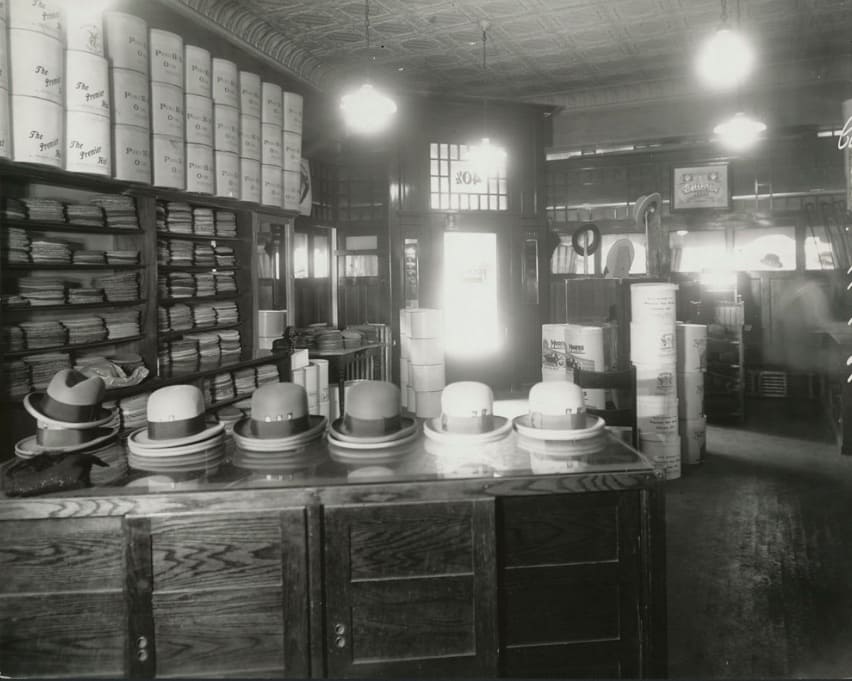 The Premier Hat Company before the fire, 1928
The Premier Hat Company before the fire, 1928
Library and Archives Canada, Mikan 4821789.With the hotel ruined, the authorities moved to clear the rubble. It took longer than expected with the city threatening legal action against the wrecking company if it didn’t hurry up. But at precisely 1.06 pm on Saturday 10 November 1928 the grand old Russell House Hotel, which had been the focal point of Ottawa social and political life for over sixty years, entered history. The last remnant to go was its 80-foot chimney. Recognizing the historic nature of the event, A. Brahinsky, a representative of City Iron & Bottle Company, announced the time of the pending demolition to allow citizens to come and watch the spectacle. Hundreds cheered as the chimney crash to the ground, brought down by heavy cables and a horse truck. There must have been a few tears, however. The Ottawa Journal commented that “there must be many among us who, as one by one the old landmarks go, feel little but loss of happy reminders of a brave and gracious past.”
Today, no trace of the old Russell House Hotel remains. The site of the hotel is now occupied by the War Memorial.
Sources:
Cockrane, William, Rev., 1895. The Canadian Album. Men of Canada; or Success by Example in Religion, Patriotism, Business, Law, Medicine, Education and Agriculture, Bradley Garretson & Co: Brantford,
Evening Journal (The), 1924. “Fixed Hotel Assessments,” 2 October.-
—————————, 1925. “Reached No Decision Over Hotel Request, 23 January.
—————————, 1925. “New Russell House Is Going Out Of Business After Being In Operation Over 50 Years,” 1 September.
—————————, 1925. “Russell Hotel Comes To An End Of Long Career,” 1 October.
—————————, 1928. “Five Firemen Hurt When Russell Block Is Prey To Flames,” 16 April.
—————————, 1928. “Russell Hotel For 60 Years Past An Intimate Part Of City Life,” 16 April.
—————————, 1928. “Demolish Russell,” 9 November.
—————————, 1928. “Hundreds Watch Demolition of Big Chimney At Russell,” 12 November.
—————————, 1928. “The Old Russell House: Some Memories,” 13 November.
—————————, 1934. “Understanding Shown In Letters Between King, Ministry and Ottawa Concerning Beautification of City, 6 January.
Ottawa Citizen (The), 1863. “Russell House,” 17 July.
————————-, 1925. “Russell Hotel Closes Doors: Passing of Historic Hotel Is Devoid Of Any Ceremony,” 1 October.
————————-, 1928. “Fire Will Help Park Scheme To Pass Commons,” 16 April.
Story written by James Powell, the author of the blog Today in Ottawa's History.
Retired from the Bank of Canada, James is the author or co-author of three books dealing with some aspect of Canadian history. These comprise: A History of the Canadian Dollar, 2005, Bank of Canada, The Bank of Canada of James Elliott Coyne: Challenges, Confrontation and Change,” 2009, Queen’s University Press, and with Jill Moxley, Faking It! A History of Counterfeiting in Canada, 2013, General Store Publishing House, Renfrew, Ontario. James is a Director of The Historical Society of Ottawa.
The Russell Theatre
15 October 1897
On the site of the National Arts Centre (NAC) there once stood an earlier playhouse called The Russell Theatre with its front entrance on Queen Street. On hundred years ago, it was the centre of arts and culture in Ottawa just as the NAC is today. The three-storey structure, which cost $100,000 to build, was owned by The Russell Company, the proprietor of the adjacent Russell House Hotel, which was itself the city’s leading hotel prior to the building of the Château Laurier. Work on the site began at the end of March 1897 when labourers tore down the old “Leader Hotel,” also known as the “Walsh building,” on Queen Street. The Russell Company, seeking the finest that money could buy, hired the New York theatrical architectural firm of J. B. McElfatrick and Son that had built theatres across the United States. Michigan native Fuller Claflin was the on-site architect. The general contractor for the project was Mr “Ed” C. Horne of New York, with whom Claflin had worked on many similar assignments. Imported talent, mostly from the United States, also made the stage decorations, the tile mosaics, the papier maché work, as well as the ornamental paintings and frescos. Even the masons and bricklayers employed on the job came principally from New York. Dr W. A. Drowne, who had been the manager of the Plattsburgh theatre in Plattsburgh, New York, was hired to manage the new Russell Theatre.
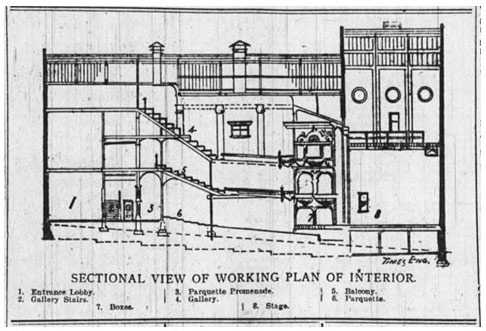 Cross section of The Russell Theatre
Cross section of The Russell Theatre
The Evening Journal, 2 October 1897.The theatre, which was built in the Italian renaissance style, was a marvel of late nineteenth century technology, and was judged second to none among North American theatres. It seated roughly 1,500 patrons on three floors and in ten boxes. On the balcony, there was a large room where light refreshments were served during intermissions and after performances. A ladies’ parlour (a.k.a. bathroom) was to be found on the first floor, with the gentlemen’s toilets on the balcony level. In the gallery, there was a smoking lounge for gentlemen. The steam-heated building was equipped with the latest stage apparatus and a modern electrical lighting system, with the wires carefully run through brass tubing to deter fires. In the case of fire, it had a fire pump with ten water outlets each equipped with fire hoses distributed throughout the building. The ground floor was laid in concrete, and the stairwells were separated from the auditorium by brick walls. The proscenium opening was protected by an asbestos curtain. Asbestos was also used in the plaster to retard burning. In an act of hubris suitable for a Greek tragedy, The Evening Journal said the theatre was “practically fireproof.”
On 15 October 1897, the Russell Theatre officially opened its door to the general public. Seats for the premiere had been auctioned off a few days earlier, with the proceeds in excess of the established ticket prices donated to the Prescott and Russell Fire Relief Fund. Roughly $200 were raised to help victims of a massive bush fire that had earlier destroyed three villages in eastern Ontario—Casselman, South Indian and Cheney’s—killing at least six people and leaving hundreds homeless.
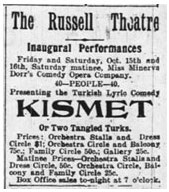 Advertisement for Kismet, the Premiere Production at The Russell Theatre
Advertisement for Kismet, the Premiere Production at The Russell Theatre
The Evening Journal, 15 October, 1897The gala opening featured Kismet or Two Tangled Turks, a comic opera in two acts by the German-born Broadway composer Gustave Kirker, with the libretto by Richard F. Carroll. Unfortunately, the play “was not altogether a success” opined The Evening Journal. The performance lacked “snap and vim” and was judged “dull” for long periods. The problem seemed to lie more with the play than with the theatrical company. The newspaper said that Miss Minerva Dorr, who played the role of the Sultan (sic) of Turkey, had a commanding presence and an exquisite voice while Mr John Saunders was very humorous as the Grand Vizier. The dancers “of the Odalisques” were also judged to be quite pleasing. In general, the theatrical company was considered to have been good, but would have done better with a better play.
If the play was lacklustre, the theatre wowed Ottawa’s elite. Prior to the beginning of the performance, coloured lights played over the stage curtain that was painted with a scene of the loops of the Selkirk River of Manitoba. Being the première, people turned out in their finest with the newspaper giving a detailed account of the outfits of prominent Ottawa women. A Miss Davis wore “a dainty dress of dresden muslin-de-soie over cream silk, the trimming of cream lace and nile green satin ribbons forming a bolero and full front bodice. Diamond and pearl ornaments.”
It seems the Journal’s judgement of the Russell’s first theatrical production was an accurate assessment of the theatre’s first seasons—second-rate. In a letter to the editor, a theatre-goer in 1899 moaned that the Russell Theatre had claimed that it had been unable to book first-rate theatrical companies since they had already been contracted to play in Toronto and Montreal. He thought that while the excuse might have been a fiction, the result was “painful.” Another angry theatre patron complained that if Ottawa had to put up with second-rate attractions, at least the prices charged shouldn’t be higher than those charged in Montreal.
Fire put an end to the complaints. On 9 April 1901, roughly two hours after the last patrons had left a production of The Belle of New York, a musical comedy written by Hugh Morton with music again by Gustave Kirker, a fire broke out behind the Russell’s stage. Despite the asbestos curtain and other fire retarding measures, the theatre was quickly gutted, its wooden interior fixtures burning like tinder. The alarm was raised by the theatre’s caretaker who had an apartment close to the stage. He had just fallen asleep when he was woken by a loud rushing sound, with his room filling with smoke. Almost naked, he rushed out of the theatre to the nearby police station to bring help. Dr Drowne, the Russell’s manager, and Mrs Drowne who also lived in the theatre, barely escaped with their lives. They fled with only the clothes on their backs. All their possessions, valued at $2,000, were lost.
By the time Fire Chief Provost and his men got to the Russell Theatre, flames were already shooting through the roof. But firefighters were able to bring the blaze under control by plying water streams onto the structure from the Free Press Building at the corner of Queen and Elgin Streets. While the theatre was a write-off, the firemen were able to save surrounding buildings, including the Russell House Hotel. Aiding them was the weather—wet with the wind blowing away from the hotel.
The cause of the blaze was never ascertained. The caretaker thought it started in the furnace room. Others believed it had been caused by a wayward cigarette dropped by one of the players. However, Dr Drowne disagreed, saying he was very strict with smoking around the stage. Also, he had passed through the theatre after The Belle of New York troupe had left, and had checked on every room before retiring for the night.
The next day, Ottawa residents woke up to the realization that only by chance had a great tragedy been avoided. Had the fire broken out just two hours earlier, many men, women and children might have been trampled in a rush for the doors. Despite the considerable fire precautions taken in its construction, the consensus was that the theatre had not been safe due to insufficient exits, especially from the dress circle and balcony levels. Many considered the theatre to have been a “death trap.”
Speculation also began on whether the theatre would be rebuilt. The initial assessment was not favourable. Fire losses were estimated at $100,000, with insurance covering only $63,000. Also, the theatre had not been profitable; no dividends had been paid since the day it was opened. But at a meeting of directors four days after the fire, management announced that an arrangement had been reached to rebuild the Russell Theatre between the owners of the theatre and the Ambrose J. Small Company of Toronto, a theatre management company that had leased the Russell. Apparently, the Ambrose J. Small Company had already booked engagements for two-thirds of the coming season.
As an aside, many years later in 1919, Ambrose J. Small, who was a major Canadian theatre mogul who owned or operated theatres in several Ontario cities, was to disappear under circumstances worthy of a paperback thriller. After receiving $1.7 million from the sale of his theatre operations, it was alleged that he was murdered by his wife and her lover, with his body incinerated in the furnace of the Grand Opera Theatre in London, Ontario. The allegations were never proven. At one point, Sir Arthur Conan Doyle, the author of the Sherlock Holmes stories, was approached for assistance in solving the case. While interested, Sir Arthur declined to help. Never solved, the police closed the case in 1960.
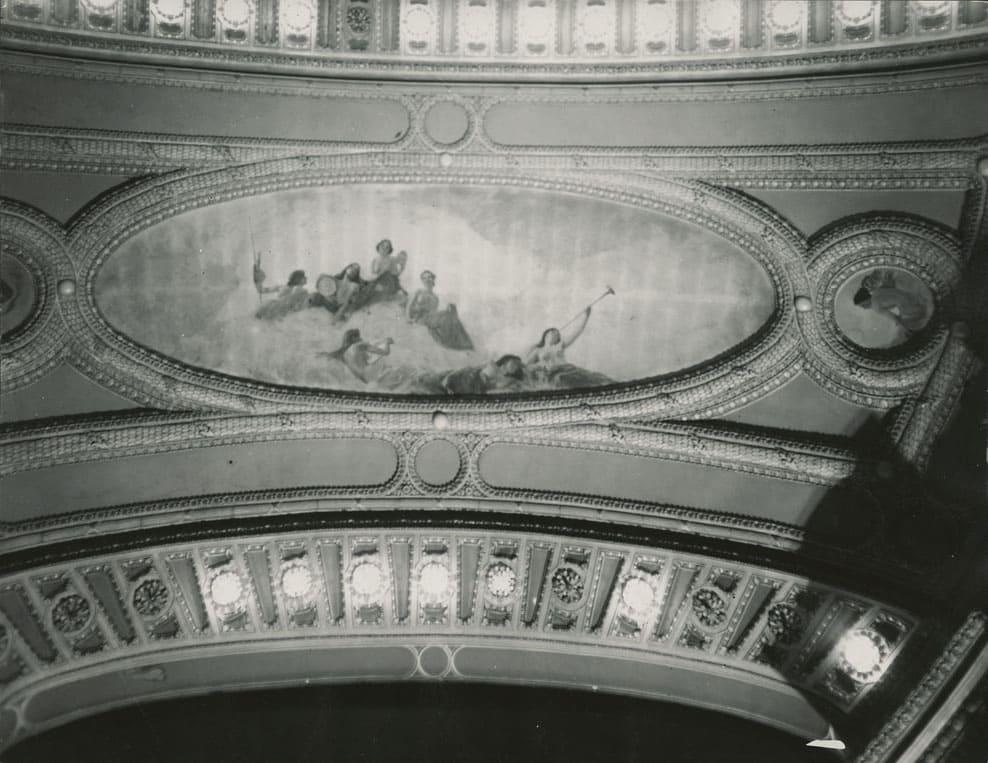 Ceiling of the new Russell Theatre showing “The Triumph of Drama” by Frederick Challener, RCA, 1928
Ceiling of the new Russell Theatre showing “The Triumph of Drama” by Frederick Challener, RCA, 1928
Library and Archives Caanda, Mikan 4821747The new Russell Theatre reopened on 7 October 1901, almost four years to the day after its first debut. Although rebuilt along similar lines to the original theatre and finished as before in old gold, ivory and red, with shades of blue under the galleries, there were significant differences. Capacity has increased to 1,900 seats from 1,500, with 590 on the ground floor, 500 in the balcony, 700 in the gallery, with the remainder accommodated in twelve boxes. There were other differences too. Most importantly, there were a lot more exits, including four on the gallery and three on the balcony. Frederick Challener, a distinguished Canadian artist, had also been commissioned to paint three murals on the ceiling, depicting the “Triumph of Drama,” “Love” and “Hate.”
The re-opening play was a production of Dolly Varden, a comic opera by the Broadway composer Julian Edwards based on the character Dolly Varden from the Charles Dickens’ book Barnaby Rudge. Miss Lulu Glaser played the lead role. This debut fared better than the first. The Journal’s review described the production as “bright and clever entertainment, while Miss Glaser was “vivacious and dainty.” Unlike Kismet in 1897, Dolly Varden had the necessary “vim.” The newspaper was particularly impressed by a chorus by the entire company performed a cappella. The costumes were also deemed to have been gorgeous.
During that first week, Dolly Varden played for two nights. This was followed by two nights of vaudeville by Shea’s Vaudeville from the Garden Theatre in Buffalo. The week was rounded out by a performance by Louis Morrison in The New Faust on the Friday, followed by Madame Modjeska and Louis James in productions of Mary Stuart and Henry VIII on the Saturday.
The curtain fell for the last time at the Russell Theatre on 14 April 1928. The theatre, along with the now empty Russell House Hotel and other properties on the Russell Block bordered by Sparks, Queen and Elgin Streets and the Canal had been acquired by the Federal District Commission (FDC). All were slated for demolition as part of the Commission’s plan to beautify Ottawa. On that last night, The Dumbells performed in “Bubbling Over,” a series of eleven comedic and musical acts, to a capacity crowd. Led by Captain Merton Plunkett, the troupe was a prominent and extremely popular Canadian vaudeville group that had been formed during World War I by members of Canada’s Third Division. The company took their name from the dumbbell emblem of the Third Division. At the end of their performance, Captain Plunkett told the audience that it was fitting that a strictly Canadian company should be the last to appear at the Russell.
As The Dumbells were loading their props and other equipment onto a horse-drawn cart after their show, the derelict Russell House Hotel caught fire. Although firemen were able to save the adjacent Russell Theatre from the flames, nothing could save it from the FDC. Three months later, it was demolished. Fortunately, on hearing of the existence of the beautiful ceiling murals by Frederick Challener, Canada’s National Gallery asked that they be saved. The murals now reside at the Gallery. In 1985, the Gallery also obtained Challener’s preliminary scale model of the main mural, Triumph of Drama. See Maquette of Triumph of Drama.
Sources:
Alberti, Louis-Gèrard, 2015. “The Russell Theatre,” The Canadian Encyclopedia.
Bordman, Gerald with Norton, Richard, 2010. American Musical Theatre, A Chronicle, 4th Edition, Oxford University Press: Oxford, New York.
Evening Journal (The), 1897. “Ottawa’s New Theatre,” 30 March.
—————————, 1897. “Down Comes The Wall,” 30 March.
—————————, 1897. “The Russell House Company,” 7 June.
————————–, 1897. “Opera House Decorations,” 14 July.
————————–, 1897. “At Work On The Scenery,” 18 August.
————————–, 1897. “With The Labor Men,” 21 August.
————————-, 1897. “An Up To Date Theatre,” 2 October.
————————-, 1897. “The Russell Offer,” 9 October.
————————-, 1897. “$200 For Fire Sufferers.”
————————-, 1897. “Up Goes The Curtain,” 16 October.
————————-, 1899. “The Russell Theatre,” 18 September.
————————-, 1899. “The Russell Theatre,” 23 September.
————————-, 1901. “The Theatre Fire,” 9 April.
————————-, 1901. “Russell Theatre A Ruin Today,” 9 April.
————————-, 1901. “Opposed To Rebuilding,” 9 April.
————————-, 1901. “Did Not Pay,” 10 April.
————————-, 1901. “Music And Her Devotees,” 13 April.
————————-, 1901. “Theatre To Be Rebuilt,” 13 April.
————————-, 1901. “Russell Will Open Oct. 7,” 25 September.
————————-, 1901. “The Theatre Is Completed,” 4 October.
————————-, 1901. “At The Theatre, Opening Of The Russell,” 8 October.
————————-, 1928. “Dumbells’ Review ‘Bubbling Over,’ A Delight In Music And Comedy,” 10 April.
————————-, 1928. “Five Firemen Hurt When Russell Block Is Prey To Flames,” 16 April.
————————-, 1928, “To Salvage Murals, Russell Theatre,” 22 June.
————————-, 1928. “Strip The Russell, Movable Objects,” 6 July.
Moogk, Edward and Kellman, Helmut, 2014, “The Dumbells,” The Canadian Encyclopedia, http://www.thecanadianencyclopedia.ca/en/article/the-dumbells-emc/.
NGC Magazine, 2013. “Artists, Architects and Artisans Photo Gallery, 5 November, http://www.ngcmagazine.ca/exhibitions/artists-architects-and-artisans-photo-gallery/Maquette-for-the-Triumph-of-the-Drama-Russell-Theatre-Ottawa.
Ottawa Citizen (The), 1901. “Theatre To Be Rebuilt, “13 April.
————————-, 1901. “The Russell Theatre, A Suggestion,” 12 April.
Story written by James Powell, the author of the blog Today in Ottawa's History.
Retired from the Bank of Canada, James is the author or co-author of three books dealing with some aspect of Canadian history. These comprise: A History of the Canadian Dollar, 2005, Bank of Canada, The Bank of Canada of James Elliott Coyne: Challenges, Confrontation and Change,” 2009, Queen’s University Press, and with Jill Moxley, Faking It! A History of Counterfeiting in Canada, 2013, General Store Publishing House, Renfrew, Ontario. James is a Director of The Historical Society of Ottawa.
Bob, the Fire Horse: The End of an Era
25 September 1929
On 25 September 1929, The Ottawa Evening Journal reported the death of old “Bob,” a twenty-five year old horse. It was front page news as Bob wasn’t just any horse but was Ottawa’s last fire horse. The red ribbon and cup winner at the Ottawa Horse Parade passed away in pasture, honourably retired for more than a year. He had been purchased by the Ottawa Fire Department (O.F.D.) in 1908 at the age of four from Hugh Coon. Standing 16 hands, 2 inches tall (66 inches) from the ground to the top of his withers, the jet black, 1,300 pound horse served four fire stations during his lifetime, retiring from the No. 11 station at 424 Parkdale Avenue. Old Bob wasn’t the last horse in active service, but was the last owned by the O.F.D. In late 1928, the last two-horse team, also at service at No. 11 station, was displaced when the O.F.D. purchased three motorized combination ladder and hose trucks. When the team was sold, only Bob was left, pensioned off in recognition of his many years of noble service to the City. His retirement to greener pastures was controversial. Ottawa City Controller Tulley opposed Bob’s pensioning. A delegate to the Allied Trades and Labour Association meeting held in Ottawa in the fall of 1928 wanted to know if Tulley thought the old horse deserved to be shot, and whether the councillor favoured the same treatment be given to other old employees.
Bob’s passing marked the end of an era dating back to 1874 when the City purchased the first horses for its fire department. Prior to then, firemen had to pull their fire engines manually to the scene of a fire. The first fire engine in the city dated back to 1830 when the British regiment stationed on Barracks Hills, now called Parliament Hill, acquired the Dominion, a small manually operated machine. A volunteer fire department was formed in 1838. Later, the first fire hall was established on the ground floor of Bytown’s (later Ottawa’s) City Hall on Elgin Street. During these early years, insurance companies played a major role in fire-fighting, even providing the fire equipment. The first fire stations date from 1853 when the Bytown Town Council established three “engine” houses in West, Central and East Wards, each equipped with hand-pulled engines. In 1860, the now City of Ottawa purchased two hook and ladder trucks. As each weighed more than a ton, they were supposed to have been drawn by horses. But the City was too cheap or too poor to provide the funds for horses so the engines had to be manually pulled to fires.
The volunteer fire department was neither well managed, nor very professional in its operations. According to David Fitzsimons and Bernard Matheson who wrote the definitive history of the Ottawa Fire Department, there were complaints in the 1850s of volunteers who were quick to show off their sky-blue and silver laced uniforms in parades, but were no-shows when there was an actual fire. To “secure the utmost promptitude in the attendance of the different [fire] companies and water carriers at fires,” the City began to offer in the mid-1860s significant financial premiums to first responders. “The first engine to arrive in good working order” received $12, the second $8. The first water carrier received $2 and the second $1. Although such financial incentives did indeed encourage prompt service, they also led to fisticuffs between competing firemen with fires sometimes left unattended. Even when fire fighters managed to arrive at a fire without delay, there was the occasional problem. In 1914, Mr. J. Latimer, a fire department veteran, recalled a major fire in the Desbarats building located on the corner of Sparks and O’Connor Streets that occurred in February 1869. When the fire threatened to spread to the neighbouring International Hotel, barrels of liquor were rolled out into the street to keep them safe from the flames. In the process, some were broken open and at least two detachments of firefighters went home “wobbly” and had to be replaced before the fire was extinguished.
The first fire horses arrived in 1874 when the City acquired the Conqueror steam engine with a vertical boiler from the Merryweather Company of Clapham, England for the huge sum at the time of $5,953. Considerably heavier than other fire equipment, Ottawa was obliged to buy horses to pull it—anywhere from three to six depending on weather and road conditions. That same year, Ottawa’s volunteer fire department was replaced by a professional, full time force under the leadership of Chief William Young and Deputy Chief Paul Favreau.
The first motorized fire engines were introduced in North America during the first decade of the twentieth century. In 1906, the Waterous Engine Works Company of Saint Paul, Minnesota and Brantford, Ontario produced the Waterous Steam Pumper. That same year, the Knox Automobile Company of Springfield, Massachusetts produced its motorized fire engine. Such machines quickly became popular with fire departments everywhere. Compared with horse-drawn engines, the new motorized engines were faster and cheaper to operate. Horses needed to be fed 365 days of the year, and required stabling, shoeing, harnesses, and veterinary care. Fire horses also needed to be well trained. They had to be strong, obedient, and willing to stand patiently regardless of weather conditions, noise, and swirling hot embers, flames and smoke. Motorized fire engines didn’t need to be trained, were impervious to weather, and consumed gasoline only when used.
Ottawa purchased its first motorized fire engine in 1911 following pressure from insurance companies that threatened to raise their rates if the City didn’t get into the twentieth century and acquire modern fire-fighting equipment. Chief John Graham was also insistent that the City buy motorized fire equipment for efficiency and effectiveness reasons. Although the initial outlay for a motorized fire truck was higher than that of a traditional horse-drawn vehicle, the operating costs were lower.
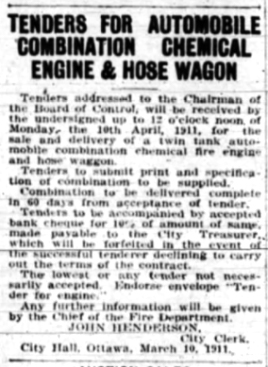 Call for Tenders for Ottawa's first motorized fire engine,
Call for Tenders for Ottawa's first motorized fire engine,
10 March 1911, The Ottawa Evening JournalChief Graham had recommended buying a motor fire truck costing $10,450 from the Webb Motor Fire Apparatus Company of St Louis, Missouri. However, City Council chose a vehicle produced by the W.E. Seagrave Fire Apparatus Company of Walkerville, Ontario (now part of Windsor), the Canadian subsidiary of a company of the same name that had been established in Ohio in 1881. The company had previously sold three of its motorized fire engines to Vancouver in 1907 and one to Windsor in 1910. The four-ton, 80 h.p. Seagrave vehicle purchased by Ottawa carried a price tag of $7,850. It was a combination chemical and hose truck capable of carrying ten firemen, two 35 gallon tanks of fire-suppressing chemicals, 1,000 feet of 2 ½ inch hose, a twelve-foot ladder plus extension, door openers, and three fire extinguishers. Fully loaded, the vehicle could attain a speed of up to 50 miles per hour on flat terrain (typically 35 mph), or 20 mph on a 5-10 per cent incline. The City had initially sought a combination automobile pumper truck with a pumping capacity of 700-800 gallons per minute. However, it opted instead for the chemical and hose truck on the grounds that a pumper truck had not yet been adequately proven though tests were underway in New York City on such vehicles.
The new Seagrave truck was shown off to Ottawa residents at the end of May 1911 when it was run out on the road with its siren shrieking for the first time. Chief Graham invited reporters to witness the truck take him, two deputy chiefs and several firemen on a tour of Ottawa along Rideau, Sparks, Bank, Elgin, Laurier and Albert Streets. It visited No. 3, 7, and 2 fire stations before parking at its new home at No. 8 station located to the rear of the Ottawa City Hall on Elgin Street. In town for the event was Mr W.E. Seagrave himself and an instructor, Mr C.E. Fern, who drove the vehicle that first time. Fern taught Fireman James Donaldson of No. 9 station how to drive the newfangled machine.
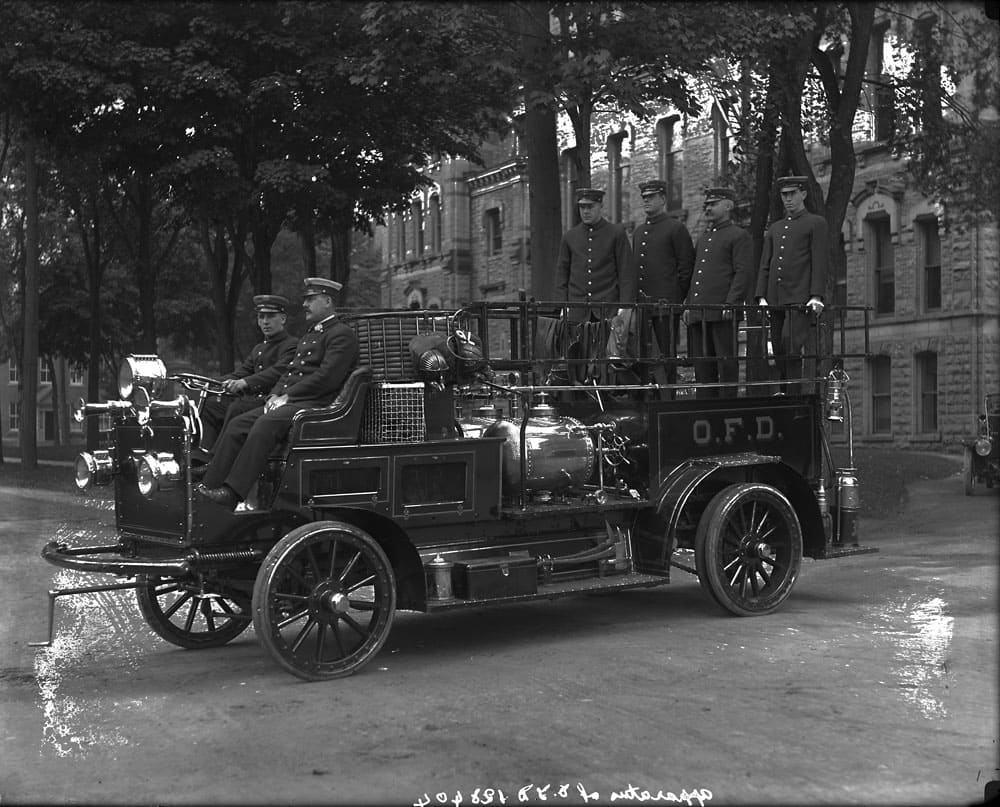 The Seagrave Chemical Hose Combination Truck, Ottawa's first motorized fire truck, 1914
The Seagrave Chemical Hose Combination Truck, Ottawa's first motorized fire truck, 1914
Topley Studio / Library and Archives Canada / PA-032798
The Ottawa Evening Journal hoped that the purchase of the Seagrave vehicle marked the start of a complete replacement by Ottawa of its horse-drawn vehicles by motorized fire trucks. (The second motorized vehicle purchased by the O.F.D. was a flash car for Chief Graham who could then retire his horse and buggy.) At that time in 1911, Ottawa’s fire department owned 46 horses, for which the cost of feed alone amounted to $4,600 per year. This was the department’s second largest budgetary item after paying the firemen’s salaries. On top of this were the ancillary costs associated with owning and taking care of horses that needed to be regularly replaced. The newspaper thought that by 1931, the whole O.F.D. might be equipped with motorized vehicles. This was a pretty accurate guess, with the motorization process taking twenty-seven years.
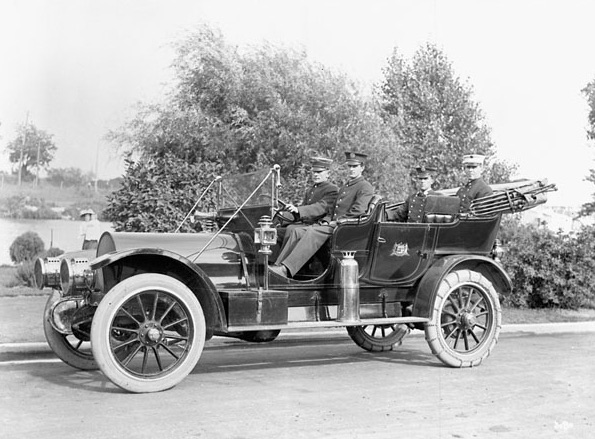 Chief Graham & assistants in auto "Fire Brigade," 1911
Chief Graham & assistants in auto "Fire Brigade," 1911
William James Topley / Library and Archives Canada / PA-010055The last major event that saw horse-drawn engines in action was the fire that consumed the old Russell Hotel in the middle of April 1928. By the end of that year, the entire Ottawa Fire Department had been motorized, leaving only old “Bob” to live out his days in green pastures far from the smoke and flames of his fire-fighting days.
Today, the Ottawa Fire Department has forty-five fire stations strategically positioned to protect close to one million people living in an area of 2,796 square kilometres. Among its equipment are pumper trucks, ladder trucks, rescue trucks, and brush trucks as well as boats, ATVs and other rescue equipment.
Sources:
Fire-Dex, 2011. The Switch from Horsepower to Motorized Fire Apparatus, September.
Fitzsimons, David R. & Matheson, J. Bernard, 1988. History of the Ottawa Fire Department, 150 Years of Firefighting, 1838-1988, Kanata: J. B. Matheson and D. R. Fitzsimons, publishers.
Morgan, Carl, 2015. “Seagrave: Birthplace of the Modern Firetruck,” Walkerville Times Magazine.
Ottawa, City of, 2017. About Ottawa Fire Services.
Ottawa Evening Journal, 1911. “Fire Chief Wants A Motor Engine,” 26 January.
——————————, 1911. “City Will Purchase An Auto Fire Engine,” 10 February.
——————————, 1911. “Read Tenders For Furniture,” 7 April.
——————————, 1911. “Deputy Chief At Eganville,” 12 May.
——————————, 1911. “Using Automobiles For Fire Purposes,” 29 April.
——————————, 1911. “Shriek of New Engine Was Heard,” 1 June.
——————————, 1914. “With the Ottawa Fire Fighters In Bygone Days,” 7 March.
——————————, 1928. “Labor To Take Keen Interest In Coming Vote,” 22 September.
——————————, 1928. “Only Two Horse In Fire Service,” 9 November 1928.
——————————, 1929. “Last Fire Horse Dies In Pasture,” 25 September.
——————————, 1930. “Chief Burnett Dies At Home Was Long Ill,” 3 November.
Saskatoon, City of, 2000. History of Webb Motor Fire Apparatus.
Wildfire Today, 2016. Horse-drawn fire engines.
Story written by James Powell, the author of the blog Today in Ottawa's History.
Retired from the Bank of Canada, James is the author or co-author of three books dealing with some aspect of Canadian history. These comprise: A History of the Canadian Dollar, 2005, Bank of Canada, The Bank of Canada of James Elliott Coyne: Challenges, Confrontation and Change,” 2009, Queen’s University Press, and with Jill Moxley, Faking It! A History of Counterfeiting in Canada, 2013, General Store Publishing House, Renfrew, Ontario. James is a Director of The Historical Society of Ottawa.
The Soviet Embassy Fire
1 January 1956
It was Sunday, 1 January 1956. Like most New Year’s Days, revellers from the previous night’s festivities were nursing sore heads. With Monday being a holiday, many Ottawa residents were happy to laze about the house and enjoy their long weekend. The virtuous and hardy braved sub-zero Fahrenheit temperatures to go to church, or attend the annual Governor General’s New Year Levee. Held on Parliament Hill, more than 1,000 Ottawa residents filed into the crimson and gold Senate chamber late that morning to be greeted by Governor General Vincent Massey, before receiving a glass of punch and a light lunch in the nearby Railway Committee Room. As was customary at the time, it was a very masculine affair. Other than Charlotte Whitton, Ottawa’s formidable mayor, and some female members of the armed forces, there were very few women present. The city’s diplomatic corps was well represented, however. Among the foreign dignitaries at the reception to shake Massey’s hand were three uniformed representatives of the Soviet Embassy. Little did they realize they were about to have a very bad day.
Following the levee, which ended in the early afternoon, the three Russian officers undoubtedly hurried back to the Soviet embassy for their own New Year’s celebrations, hosted by Ambassador Dimitri Chuvahin. Located at 285 Charlotte Street in Sandy Hill, the embassy building had once been the mansion of the Booth family, Ottawa’s lumber barons. Requisitioned by the Canadian government in 1942 for use by the Royal Canadian Women’s Naval Services, the house was instead turned over to the Russians to house the growing Soviet legation. As guests left the Soviet reception at about 4.15pm, Miss Diane Destonis, a neighbour living in the apartment building across the street, spotted smoke drifting from a window on the third floor of the embassy building. Another neighbour, Mr W. Dore, also saw the smoke. Believing it was a kitchen fire, he tried to alert the Soviet embassy by telephone; he received no reply.
The fire was caused by an electrical short circuit in the embassy’s communications room located on the upper floor of the three-storey building. Instead of immediately calling the Ottawa Fire Department for assistance, Soviet diplomats tried to put out the blaze themselves using hand extinguishers and a small fire hose installed in the building. Thirty minutes passed before the alarm was raised. Although firefighters were on the scene within ten minutes of receiving the call, flames had already engulfed the third floor. Entering by the front door of the embassy, Ottawa’s firemen, led by Chief John Foote, were stopped by embassy staff claiming diplomatic immunity. A Soviet official actually struck Chief Foote; the incident was later played down. Denied access to source of the fire, the firemen were obliged to tackle the blaze from the outside. The Soviet diplomats also impeded the firemen’s efforts by refusing to vacate the premises. Instead, they repeatedly went in and out of the embassy to retrieve filing cabinets, boxes, and files of documents. The last item to be saved from the flames was “a heavy piece of wireless equipment.” Two embassy cars, stuffed with documents, reportedly “careened” out of the embassy driveway onto Charlotte Street, running over deployed fire hoses, almost bursting them.
Incensed by the lack of Soviet co-operation, Chief Foote contacted Mayor Whitton who hurried to the scene. Shortly afterwards, R. M. Macdonnell, the deputy undersecretary of External Affairs arrived, as did Paul Martin, Sr, Minister for National Health and Welfare, substituting for Lester Pearson, Minister for External Affairs who was out of town. The mayor authorized Chief Foote to exercise all necessary emergencies powers at his disposal as Fire Marshall. At 6.30pm, he declared a state of emergency, calling in extra firemen and police support.
The fire was finally brought under control two hours later, but was not extinguished until close to midnight. One hundred firemen fought the blaze in biting cold weather, using equipment from four stations, including three pumper trucks and four ladder trucks. Although smoke and hot cinders filled the sky, a north-easterly breeze blew burning embers towards parkland and the Rideau River, sparing the embassy’s neighbours. More than three thousand spectators watched the night’s drama despite the cold. Hundreds of cars lined Riverside Drive. Meanwhile, streetcar service along Laurier Avenue East was blocked.
Thankfully, no lives were lost in the fire. But the embassy building was a write-off. Estimated losses amounted to $250,000 (equivalent to more than $2 million today). Ambassador Chuvahin and his wife, along with two other Soviet diplomats living in the building, lost their homes and their belongings. The Soviets set up a temporary embassy a short walk away at 24 Blackburn Avenue, the office of the Soviet commercial counsellor.
The next day, with the embassy building sheathed in ice, the blame game commenced. The Soviets claimed that the Ottawa Fire Department had been slow to respond, and that there had been insufficient water pressure. Mayor Whitton hotly denied the allegations, saying that the Russians had only themselves to blame by not calling in the firemen immediately, and then obstructing their access to the building. She also argued that the six-foot, spiked, iron fence installed around the perimeter of the property the previous year had made it difficult for fire equipment to be brought close to the embassy building. Additionally, extreme cold temperatures meant that water being directed onto the blaze vapourized before contact. At the city’s official New Year Reception held that afternoon, a hoarse and weary Mayor Whitton commented, “I’ve been fighting the Russians.”
The public was baffled by the Soviet effort to obstruct Ottawa’s firemen. A Citizen editorial called it “an incomprehensible act,” which put its neighbours at risk. Claims of “diplomatic immunity” in such circumstances were deemed “fantastic.” Igor Gouzenko, the Soviet cypher clerk who had defected from the Soviet Embassy nine years earlier, explained that the only reason for embassy officials to impede and delay Ottawa’s firemen was to ensure that it’s most secret documents, for example, lists of names of agents in the west and instructions from Moscow, were kept secret.
Mayor Whitton called upon the federal government to review its regulations governing diplomatic immunity in order to give firemen free access to buildings in the event of future fires. The government demurred, arguing that international rules governing diplomatic immunity had been finely crafted over many centuries, and that Canadian officials abroad were accorded the same privileges as foreign representatives were in Canada. When contacted, other diplomatic missions in Canada were also wary of any change to the law, though several commented that they would have allowed the firemen onto their premises had their embassies caught fire.
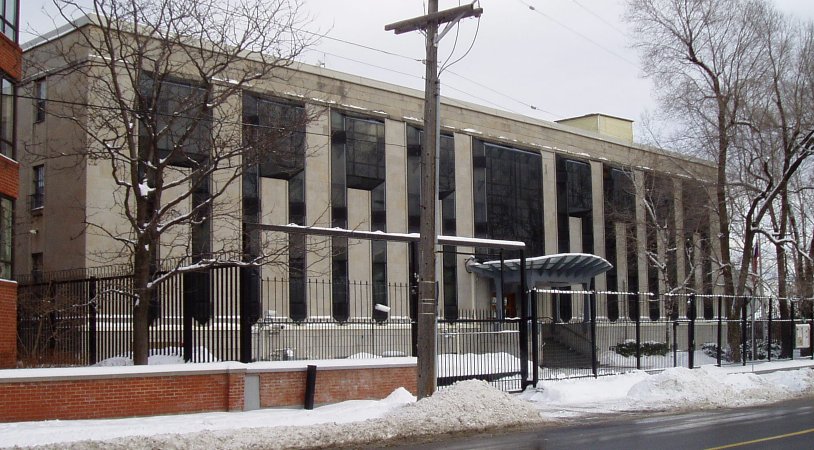 With the old Booth mansion a write-off, a new Soviet Embassy, built in the Socialist Classical style, was constructed on the same site. With the Cold War in full swing, RCMP counter-espionage agents, assisted by British MI5 agents, apparently concealed microphones in the windows of the new building while it was under construction. Called Operation Dew Worm, Igor Gouzenko provided advice to the Canadian and British spooks on the best locations to place the bugs.
With the old Booth mansion a write-off, a new Soviet Embassy, built in the Socialist Classical style, was constructed on the same site. With the Cold War in full swing, RCMP counter-espionage agents, assisted by British MI5 agents, apparently concealed microphones in the windows of the new building while it was under construction. Called Operation Dew Worm, Igor Gouzenko provided advice to the Canadian and British spooks on the best locations to place the bugs.
It seems, however, that western spy agencies gained little by this piece of high-tech skullduggery. Two books published in the 1980s, Their Trade is Treachery (1981) by journalist H. Chapman Pincher and Spycatcher (1987) by former MI5 agent Peter Wright, claim that the Russians were tipped off to the location of the bugs, and established a secure room elsewhere in the building. Allegedly, the source of the tip-off was a senior member of the British intelligence service, possibly Sir Roger Hollis, director-general of MI5 from 1956 to 1965, whom the authors claim was a Russian mole. The British government officially denied the allegations. But Wright’s memoir gained world-wide notoriety when the British government tried to keep it from being published. The case against Hollis, now dead (as are Pincher and Wright), remains unproven. The Soviet Embassy building now houses the Embassy of the Russian Federation.
As a postscript to this story, history repeated itself in January 1987. When a small, electrical fire broke out in the basement of the Soviet consulate on Avenue de Musée in Montreal, Soviet diplomats choose to fight the blaze themselves using garden hoses and snow. When neighbours called in the alarm to the fire department, Soviet officials delayed the firefighters’ entry into the building for fifteen minutes to protect documents. As a consequence, what had been a minor fire became a major five-alarm fire.
Sources:
City of Ottawa, 2014. “Soviet embassy fire,”
Gouzenko, Igor, 1956. “Secret Work of Russian Embassy Vastly Expanded Since Spy Trials,” The Ottawa Citizen, 4 January.
Lewiston Daily Sun, 1956. “Soviet Ottawa Embassy Destroyed By Fire; Aides Stay To Move Documents,” 2 January.
Los Angeles Times, 1987. “Soviets Keep Firemen Out, Montreal Consulate Burns,” 17 January.
The Globe and Mail, 1956. “Report Chief Struck—Embassy in Ottawa Burned As Russians Impede Firemen,” 2 January.
————————, 1956. “1000 Call on Massey at Levee,” 3 January 1956.
————————, 1981, “The Spy Scandal: Did Canada bug rebuilt Soviet Embassy?,” 27 March.
Toronto Star, 1987. “Fire at Soviet embassy revives 31-year puzzle,” 18 January.
The Ottawa Citizen, 1956. “Mayor Asks Way To Pry Open Embassies During Emergencies,” 3 January.
———————-, 1956. “Weary, Semi-Ill Mayor Entertains At Reception,” 3 January.
———————, 1956. “No ‘Immunity’ From Fire,” 3 January.
———————, 1956. “Flames Ruin Embassy, Red Tape Slows Fight,” 3 January.
———————, 1956. “Refused to Leave, Carried from Burning Building,” 3 January.
———————, 1956. “Senator Feared For Safety of Next-Door Residence,” 3 January.
———————, 1956. “Ottawa’s Diplomats Decidedly Cool Toward Any Curtailment of Privilege,” 4 January.
———————, 1956. “Traditional Colorful Scenes At Governor-General’s Levee,” 3 January.
Wright, Peter, 1987, Spycatcher: The Candid Autobiography of a Senior Intelligence Officer, Stoddart Publishing Co. Ltd: Toronto.
Images:
Soviet Embassy after the Fire, 1956, City of Ottawa, 2014. “Soviet embassy fire,”
Story written by James Powell, the author of the blog Today in Ottawa's History.
Retired from the Bank of Canada, James is the author or co-author of three books dealing with some aspect of Canadian history. These comprise: A History of the Canadian Dollar, 2005, Bank of Canada, The Bank of Canada of James Elliott Coyne: Challenges, Confrontation and Change,” 2009, Queen’s University Press, and with Jill Moxley, Faking It! A History of Counterfeiting in Canada, 2013, General Store Publishing House, Renfrew, Ontario. James is a Director of The Historical Society of Ottawa.
The Rideau Club Fire
23 October 1979
Ottawa’s history has been marked by major fires that have reshaped its contours. Most devastating were the massive conflagrations of 1870 and 1900 that twice destroyed much of the western suburbs of the capital, as well as large chunks of Hull on the Quebec side of the Ottawa River. The mysterious and deadly fire of 1916 that gutted the Centre Block on Parliament Hill is also worthy of a “dishonourable” mention. Other historic buildings lost to flames include the Russell Hotel, destroyed in 1928 and the old City Hall, gone in 1931. The former stood at the corner of Elgin and Sparks Street, roughly where the War Memorial is located today, while the site of the latter is now Confederation Park on Elgin Street. A more recent calamity was the fire that consumed the Rideau Club building during the evening of Tuesday, 23 October 1979. The landmark building had one of the most prestigious addresses in the Capital, being located at 84 Wellington Street on the corner of Metcalfe Street, immediately across from the front gates of Parliament and right beside the then American embassy.
For those unfamiliar with the Rideau Club, it is unquestionably the senior, and most exclusive, private club in Ottawa. It was founded in 1865, the year prior to Confederation, by an act of the Province of Canada. The Bill, titled an Act to Incorporate the Rideau Club of the City of Ottawa, sailed quickly through both the Provincial legislature and the Legislative Council (the upper house of Parliament), spurred no doubt by the fact that more than two-thirds of the Bill’s sixty-three petitioners were parliamentarians. The Club was modelled after the British gentlemen’s club that had become very popular in Victorian London. Such clubs provided a haven for gentlemen, or aspiring gentlemen, seeking a quiet respite from home life and a place to entertain guests. The clubs were also useful for business meetings and networking. Although Ottawa in 1865 had lots of taverns and bars catering to its many loggers, there was little in the way of refined amenities. The capital was still a small, rough-hewed, shanty town that had been cut out of the wilderness only thirty years earlier. At a stretch, its population may have been about 18,000. But having been named the capital of Canada in 1857, and with the construction of the parliamentary and government buildings nearing completion, the town was welcoming an influx of parliamentarians and senior civil servants used to the creature comforts of Toronto, Quebec or Montreal. The Rideau Club was their way of bringing some of the finer things of life to the nation’s capital.
The Club’s constitution and rules drew heavily from those of Montreal’s St-James Club established in 1858, with its membership transcending language, religion and political barriers. Its initial membership list reads like a roll call of Canada’s notables of the time. First on the list of petitioners was none other than the Conservative John A. Macdonald, who at that time was the Premier of Canada West, and, along with Sir Naricisse-Fortunat Belleau, who was the Premier of Canada East, headed the last government of the Province of Canada before Confederation. Macdonald subsequently became the first Premier of the new Dominion of Canada following Confederation in 1867, receiving a knighthood for his work in uniting the British colonies of North America. Macdonald was to become the Rideau Club’s first president. Second on the list was George-Étienne Cartier, who had shared the premiership with Macdonald in an earlier Provincial government. Like Macdonald, Cartier was a “father of Confederation,” and was made a baronet by Queen Victoria for his role in founding the Dominion of Canada. Eight other “fathers of Confederation” were on that first membership list, including D’Arcy McGee, who was assassinated in 1868, George Brown, the fiery Reform leader who founded The Globe newspaper, the above-mentioned Sir Narcisse-Fortunat Belleau, and Hector-Louis Langevin who was later embroiled in the Pacific Scandal of 1873 involving bribes in the bidding for a national railway. Another founding member of the Rideau Club was John Sandfield Macdonald who also had been a former Premier of the Province of Canada. After Confederation, he became the first Premier of Ontario. Ottawa’s entrepreneurial elite were also represented on the initial Club subscription list. Robert Bell, the editor and owner of The Ottawa Citizen newspaper and Alonzo Wright, a lumber baron, were founding members.
The club’s first home was at 200 Wellington Street, the location of Doran’s Hotel, Ottawa’s leading inn at the time. In 1869, the Club moved to the Queen’s Restaurant, located at the eastern corner of Wellington and Metcalfe Streets, the site of the Langevin Building today named in honour of Hector-Louis Langevin. In 1876, the Club moved to the other side of Metcalfe Street when the Rideau Club Building Association acquired land for $4,000 from the famed Ottawa photographer, James Topley, and built a modest clubhouse. With the subsequent purchase of an adjoining lot, the building was enlarged on three occasions, the last in 1911, to meet the needs of the Club’s expanding membership. This building, with its front doors facing Parliament Hill, would be the Club’s home for 103 years.
Although the Club welcomed members from all political stripes, francophones, anglophones, Catholics and Protestants, it was strictly men only. Also like most private gentlemen’s clubs of the time, Jews were not welcome; anti-Semitism, though often subtly expressed, was widespread in Canada. Although the Club’s membership rules did not explicitly reject Jewish membership, the selection process for members effectively did so. Should a member propose a Jew for membership, it only required a small, anti-Semitic minority to anonymously block the application. Two rejections meant that an applicant was “blackballed” (i.e. barred) for life. It took almost one hundred years before the Club admitted its first Jewish members in 1964, a reform made possible be changing in the selection mechanism so that members were required to give reasons for vetoing an application. Among the first Jewish members were Louis Rasminsky, the Governor of the Bank of Canada, and Lawrence Frieman, the owner of a major Ottawa department store and a prominent philanthropist. It took another fifteen years before women broke down similar discriminatory barriers. Jean Pigott, a former Member of Parliament and an adviser to Prime Minister Joe Clark became the first female member in the summer of 1979, just months before the Rideau Club was gutted by fire.
The fire, which destroyed the four-story edifice, began at about 5pm on the evening of 23 October 1979, a timing to which I can personally attest as I was outside the Rideau Club shortly after the fire was detected. I had been walking along Sparks Street after work on the way to W.H. Smith bookstore when I smelt an acrid odour as I approached the corner of Sparks and Metcalfe Streets. Seeing a curl of smoke coming off of the Rideau Club roof, I rushed to a gift shop on Metcalfe Street to use its telephone to raise the alarm. I was in the process of dialling when I heard the arrival of fire engines. Over the next several hours, I stayed to watch the unfolding drama from the safety of the Parliament Hill lawn, along with several thousand passersby, civil servants, and parliamentarians, including Prime Minister Joe Clark.
With the Club’s telephone lines dead, the fire was called in by a Club staff member who had gone to a Sparks Street clothing store to use their telephone. He had initially tried the neighbouring U.S. embassy, but got no response at the front door. At the time, there was only one member inside the Club, former Governor General Roland Michener who was eating toast and drinking tea while reading a newspaper in an upstairs sitting room. With considerable understatement, the Club’s bartender, Philip Sylvain, informed Michener that “there may be a slight fire,” and advised him to leave the building. After the hall porter help him to don his overcoat, the 80-year old former governor general made his way to the National Press Club for dinner where he created pandemonium when he informed journalists that the Rideau Club was on fire.
Apparently starting in the basement, near the elevator shaft, the blaze quickly spread through the building, its path facilitated by the building’s dry wooden interior coated by many layers of paint. Although the Club had recently been renovated, there were no sprinkler system. The cause of the fire was never clearly ascertained. Initial suspicions focused on the furnace boiler or faulty wiring, but Ontario’s Fire Marshall’s Office later rejected both possibilities. In the event, sixty fire fighters responded to the alarm with seven pumper trucks, three aerial trucks and two ladder trucks, as well as a squad truck and other emergency vehicles. Fifty policemen secured the scene and directed traffic, while an estimated 6,000 people looked on from Parliament Hill.
As night fell, the flames lit up the sky. At 6.20pm, the flag on the roof the Club caught fire. Shortly afterwards, the heavily-painted balcony burst into flame, spectacularly illuminating the structure. At the fire consumed the historic building, Rideau Club members, and indeed all of Ottawa, grieved. One member described the event as “going to the funeral of an old friend.” The building was completely gutted. Along with its meeting place, the Club lost priceless records, and many works of art, including two paintings by the famed Group of Seven artist, A.Y. Jackson. Surviving were some cutlery, plates, and seven 19th century Ottawa prints salvaged from the Ladies’ dining room. An Inuit soapstone carving used as a Billiard Trophy was also recovered from the wreckage. Amazingly, more than $10,000 worth of wine and liquor was additionally retrieved, having been stored in a cellar protected by thick, stone walls.
Also gone in the blaze were priceless artifacts housed in the National Capital Commission’s tourist centre located in a corner of the Rideau Club building. Lost treasures included 150-year old model of an 18th century fighting ship, tools used in the construction of the Rideau Canal during the 1820s, and a hand-woven tapestry. As well, tourist brochures worth $100,000 were destroyed.
With the wind blowing from the east, the Rideau Club’s immediate neighbour, the Beaux-Arts U. S. Embassy building constructed in 1931, avoided damage. A firewall and timely action by fire fighters also spared the adjoining Blackburn building at the rear. However, sparks and burning embers from the Rideau Club fire threatened the Langevin Building, home of the Prime Minister’s Office, on the western side of Metcalfe Street. Although the fire jumped the road, firemen were able to contain the blaze to the eastern roof of the Langevin Building, using a turret gun and two hand lines that pumped 750 gallons of water per minute onto the roof. As a precautionary measure, staff were evacuated and furniture and files were moved into the interior hallways. Even though the building was saved, the damage, estimated at $500,000, was extensive.
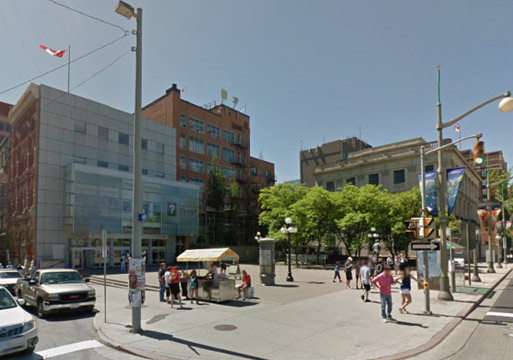 Site of the Rideau Club taken from the same angle as the earlier c.1910 Topley photograph
Site of the Rideau Club taken from the same angle as the earlier c.1910 Topley photograph
May 2016, Google StreetviewThe next morning, Ottawa citizens awoke to the sight of a smoldering, burnt-out shell in the heart of their city. The cost of the fire was placed in the millions. Although Club members hoped that the exterior walls might be saved and the structure rebuilt, the government, which had expropriated the building in 1973, quickly concluded that the edifice was unsafe and beyond repair. With a pending visit by U.S. President Carter, the remains of the Rideau Club were demolished with almost unseemly haste three weeks after the fire.
Neither the Langevin Building nor the Rideau Club building were insured. When the government decided to expropriate the Rideau Club building to make way for a possible future Parliamentary building—an idea that was subsequently quashed owing to high costs—it had originally offered Club members a meagre $1.3 million in compensation. Taking the matter to Federal Court, Club members in 1980 were finally awarded $10.5 million, including interest, in compensation by Mr Justice James Jerome, one of the few Federal judges who was not a member of the Club.
After using the Chateau Laurier as an interim home after the fire, Club members applied their compensation money to purchase the fifteenth floor of the Metropolitan Life Insurance Company building at 99 Bank Street, paying more than $5 million for the floor. An additional $3 million was spent on furnishings. From this penthouse floor, members have a fine view of the Parliament buildings and the surrounding Ottawa skyline.
Today, the site of the old Rideau Club building is an open square, featuring a stature honouring Terry Fox, the one-legged marathon runner who died from cancer in 1981 while attempting to run across Canada.
Sources:
Lynch, Charles, 1990. Up from the Ashes: The Rideau Club Story, Ottawa: University of Ottawa Press.
McCreery, Christopher, 2015. Savoir-Faire, Savoir Vivre: Rideau Club 1865-2015, Dundurn: Toronto.
Ottawa Citizen (The), 1979. “Historic Rideau Club In Ruins,” 24 October.
————————-, 1979. “Priceless exhibits lost from NCC’s Collection,” 24 October.
————————-, 1979. “Flames Posed Security Worry,” 24 October.
Ottawa Journal (The), 1979. “Members could only watch and grieve,” 24 October.
————————–, 1979. “Fire cause puzzles investigators,” 25 October.
————————–, 1979. “Entire city block lay at wind’s mercy.” 25 October.
————————–, 1979. “Rideau Club death marks changing face of Ottawa.” 25 October.
————————–, 1979. “Rideau Club blaze began near elevator.” 1 November.
————————–, 1979. “Rideau Club will crumble,” 7 November.
Province of Canada, 1865. Statutes, 4th Session of the 8th Parliament
Story written by James Powell, the author of the blog Today in Ottawa's History.
Retired from the Bank of Canada, James is the author or co-author of three books dealing with some aspect of Canadian history. These comprise: A History of the Canadian Dollar, 2005, Bank of Canada, The Bank of Canada of James Elliott Coyne: Challenges, Confrontation and Change,” 2009, Queen’s University Press, and with Jill Moxley, Faking It! A History of Counterfeiting in Canada, 2013, General Store Publishing House, Renfrew, Ontario. James is a Director of The Historical Society of Ottawa.



